2020 Robert Allerton Award Presented to P. Barry Tomlinson for Extraordinary Contributions to Botany and Horticulture

Kalaheo, Hawaii (May 3, 2022)—The National Tropical Botanical Garden (NTBG) has announced that it has named P. Barry Tomlinson as recipient of the 2020 Robert Allerton Award for his contributions to botany and horticulture. The award was presented to Tomlinson in Boston by NTBG CEO and Director Janet Mayfield and NTBG President Chipper Wichman on March 31.
P. Barry Tomlinson is an Edward C. Jeffrey Professor on Biology, Emeritus at Harvard University and noted expert in the study of the palm family (Arecaceae).
The Robert Allerton Award is presented every other year in recognition of individuals who have made extraordinary contributions to botany or horticulture. Tomlinson was selected as the 2020 recipient after being nominated by NTBG senior research botanist Dr. David Lorence.
Lorence said Tomlinson’s extensive contributions to understanding the biology and function of a wide range of tropical plant groups made him a natural choice to receive the Allerton Award. He praised Tomlinson as an “outstanding botanical mentor” who taught his students to “ask the plants” by studying their functionality on micro and macroscopic levels.
Recalling his enthusiastic teaching style, Lorence described Tomlinson’s delight in demonstrating how a chainsaw and machete could be used to deconstruct a palm, laying out fronds and inflorescence to illustrate how a tree’s parts form the whole. Tomlinson was equally enthusiastic about examining thin sections of plant tissue under a microscope to show students structural anatomy at the cellular level.
From his decades of research to his devotion in teaching generations of future botanists,” Lorence said, “Barry Tomlinson has been a major influence in the world of tropical botany.”
Internationally known for his study of palms, Tomlinson was lead author of the influential The Anatomy of Palms, long considered the definitive reference work showcasing the singular role of the palm family. Additionally, Tomlinson has authored The Botany of Mangroves, Architecture of Tropical Plants, and numerous books and publications on the anatomy and morphology of monocots, the biology of coastal and marine plants including seagrasses, mangroves, and the plants of the Everglades. Additionally, he has published works related to developmental morphology and the reproductive biology of gymnosperms, including Cycads.
Phillip Barry Tomlinson was born in 1932 in Leeds, England where he says he first experienced a curiosity for plants in “the meadow just over the garden wall.” As an undergraduate at the University of Leeds, his fascination with plants grew as he earned a Bachelor of Science and Ph.D.. While a graduate student, Tomlinson began working closely with palms at the Royal Botanic Gardens, Kew. Fortuitous timing allowed him the opportunity to dissect and examine a large number of palm trees during a period when the Kew greenhouse was being renovated.
Tomlinson was later appointed to a position at the University of Singapore Botanic Gardens where his fascination with Arecaceae deepened, leading him to travel to West Africa where he was appointed to the faculty of the University of Gold Coast (University of Ghana) for three years in the late 1950s. During that period, he studied palms and their connections to people along coastal West Africa as far south as Cameroon.
From Africa, Tomlinson relocated to Miami, Florida where he began collaborating with the Fairchild Tropical Botanic Garden, the Montgomery Botanical Center, and NTBG’s garden The Kampong located in Coconut Grove. It was there, through his association with Kampong director Larry Schokman, that he forged a relationship with NTBG.
After NTBG offered Tomlinson a research associate position, he embarked on developing a summer teaching course for Harvard University using lab space at The Kampong and Montgomery Botanical Center. While teaching in Miami, Tomlinson had a student named Kiat W. Tan, later known for his role in helping develop Singapore’s concept of a “city in a garden.”
While working at the Montgomery Botanical Center, Tomlinson made fundamental discoveries about the gymnospermous group Cycads based on material cultivated at the center, thereby illuminating characteristic features of their anatomy.
Dr. Patrick Griffith, executive director of the Montgomery Botanical Center, called Tomlinson a “titan among botanists,” saying he was fortunate to have worked with him. “His mastery of classic and fundamental techniques fosters genuine discovery and deep understanding of our plant world,” Griffith said, adding, “Barry is a gifted educator as well. His courses on tropical botany are legendary. Truly, there are very few as deserving as Barry for this high honor.”
Upon learning that he had been selected to receive the Allerton Award, Tomlinson said, “With becoming modesty I am happy to accept the Allerton Award and am honored to be in the company of such distinguished previous recipients.”
Tomlinson attributed much of his success to a long list of mentors and teachers who, he says, guided him on his path to a life of botany. Those named include University of Leeds botany professor Irene Manton who he says, facilitated his acquisition of scholarships and promoted his research. Other noteworthy influences include Charles Russell “C.R” Metcalfe, keeper of Kew’s science laboratory and Harold E. Moore, director of Cornell University’s Bailey Hortorium.
A plainspoken Yorkshireman to his core, Tomlinson, admitted his professional journey has been most unlikely, recalling himself as once a “callow youth from the wastes of the north of England, bouncing around the tropics looking at coconuts.” Never one to mince words or indulge in exaggeration, Tomlinson spoke highly of the towering trees at the center of his career, noting how the palm’s distinctive construction is entirely primary, composed of single axis stem tissue that lives throughout its life, growing mostly in height, not thickness, adding that palms certainly are, by definition, trees. “What’s the definition of a tree?” Tomlinson asked. “A tree is something if you climb and fall out of, you’ll break your neck,” he quipped.
The Robert Allerton Award for Excellence in Tropical Botany or Horticulture is named after one of NTBG’s founding trustees and its principal initial benefactor, and consists of a bronze medal and honorarium. The award was first presented in 1975 to Dr. Richard E. Holttum of Royal Botanic Gardens, Kew. Other past recipients include Dr. Harold St. John, Bishop Museum (1981), Dr. F. R. Fosberg, Smithsonian Institution (1983), Dr. Peter H. Raven, Missouri Botanical Garden (1988), Dr. Warren L. Wagner, Smithsonian Institution (1994), Dr. Natalie Whitford Uhl, Cornell University (2003), Prof. Sir Ghillean Prance, Eden Project (2005), and Dr. David Lorence, NTBG (2017). Prof. Tomlinson is the 22nd recipient of the Allerton Award.
The National Tropical Botanical Garden is a not-for-profit, non-governmental institution with nearly 2,000 acres of gardens and preserves in Hawaii and Florida. Its mission is to enrich life through discovery, scientific research, conservation, and by perpetuating the survival of plants, ecosystems, and cultural knowledge of tropical regions. NTBG is supported primarily through donations and grants.
Media contact: media@ntbg.org
Restoring Kauai’s Native Forests
Nearly one-third of Hawaiian flora is on the U.S. Endangered Species List, and more than 230 species have less than 50 individuals remaining in the wild. Since 2016 NTBG and conservation partners statewide have been working to halt the extinction of Polyscias bisattenuata – and it’s working.
On the steep montane face of the island’s windward side, the tradewinds whistle through thick vegetation in an almost melodic manner. There are no roads or structures here, but there is a tiny population of Polyscias bisattenuata – a critically endangered Hawaiian tree nestled in the vegetation and living on the brink of extinction.
“Endemic Hawaiian species have intrinsic value and a rightful place in this landscape.”
“Endemic Hawaiian species have intrinsic value and a rightful place in this landscape,” said Julia Douglas, a Ph.D. student at the University of Hawaii, field botanist, former NTBG intern, and now research collaborator. “A deep in-situ environmental understanding of species is critical to being thoughtful stewards and conducting applicable conservation research,” she continued.
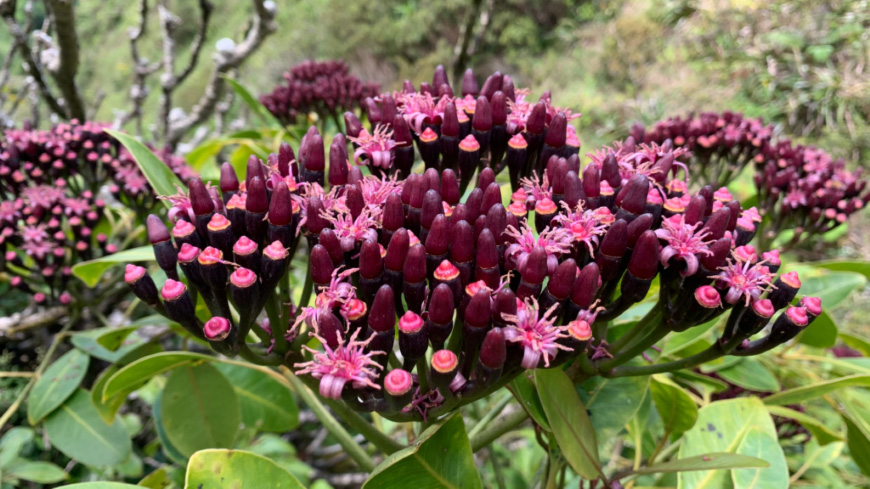
Julia is part of a vast team of scientists, conservationists, volunteers, and supporters from various organizations across the state who have been astute and careful stewards of this incredibly rare species for the last five years. Known to have fewer than 30 individuals remaining in the wild until a 2016 discovery by Natalia Tangalin, former NTBG Living Collections botanist and field collector, Polyscias bisattenuata is a member of the ginseng family (Araliaceae), and also known by the Hawaiian names ohe mauka or ohe ohe. The attractive multi-trunked tree with captivating pink flowers and deep purple fruit is endemic to Kauai’s mesic and wet native forest and documented on the U.S. Federal Endangered Species List, and listed as Critically Endangered on the IUCN Red List.
In the fall of 2016, working with the support of a grant from the Mohamed bin Zayed Species Conservation Fund, Natalia discovered 34 new trees in four previously unknown populations. Her find created a rare opportunity and momentous effort to study, propagate, and establish a stable population of Polyscias bisattenuata in its natural habitat that five years on is making an impact.
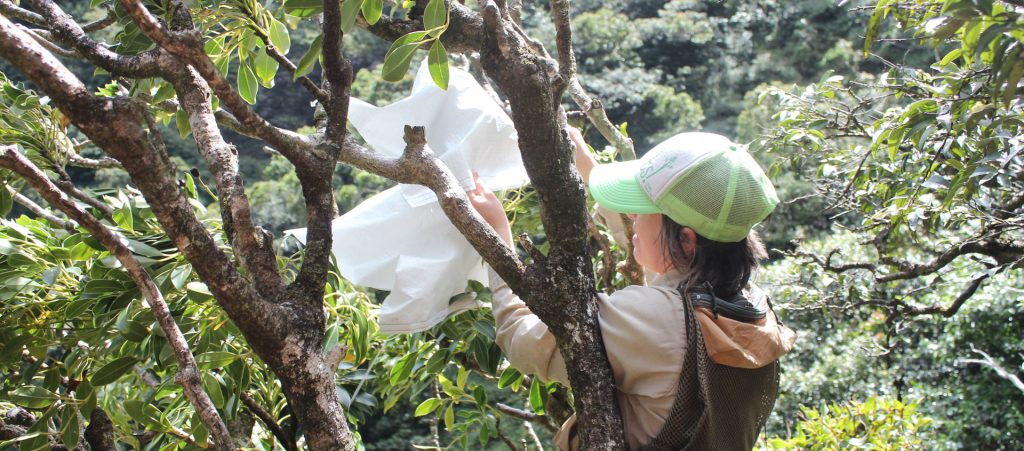
A RARE OPPORTUNITY
Like many native plants in Hawaii, protecting fruit and seeds from invasive predators is one of the greatest challenges to conservation success. Natalia’s discovery led to an all-hands-on-deck effort by NTBG Living Collections staff, volunteers, and interns to protect the fruit on the trees in hopes of collecting enough seed to study, store, and propagate.
Upon learning of the need to protect Polyscias bisattenuata fruit, NTBG’s Oshibana volunteer craft group offered to design and sew rodent-resistant bags that could be secured over the fruit and branches of the tree to deter rats. After experimenting with many different materials and designs, two volunteers, Maryanne Nordwall and Joanne Watson settled on woven plastic mech sandbags which were easily available on Kauai, flexible, and most importantly unappealing to invasive predators. Together the volunteers sewed more than 100 bags of various sizes with velcro closures that allowed for secure fastening to tree branches and safety for the imperiled fruit. The protective bags worked well and shielded the fruit from rodents until maturity. Over multiple visits, Natalia, NTBG Living Collections field collectors, and KUPU members were able to return and collect more than 55,000 seeds, adding 50 accessions to NTBG’s living collections.
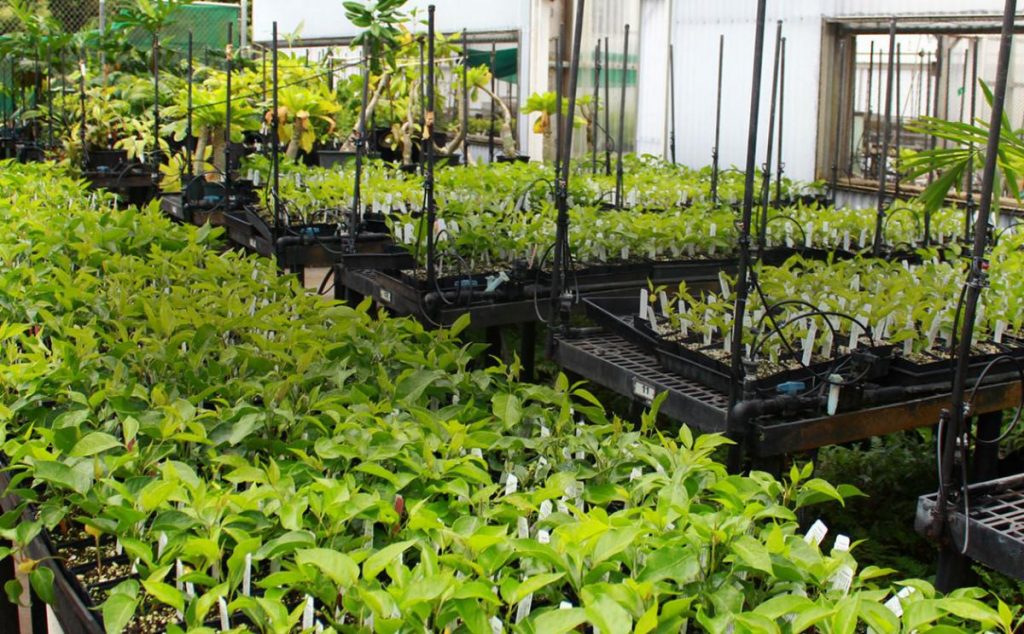
SAVING SEEDS AND MAKING A COMEBACK
Once harvested seeds were brought back to the NTBG Nursery and Horticulture Center as well as the Seed Bank and Laboratory. Horticulture staff, volunteers, and interns began the monumental task of squeezing out seeds from thousands of fruits to be cleaned, sorted, counted, and potted within hand-built cages to protect from rats. Before long the NTBG nursery was filled with a bright green sea of seeds popping out of a perlite-vermiculite substrate.
“With wild regeneration nearly absent, the burden of survival for this species and its unique sub-populations rests heavily on our Nursery team.”
“With wild regeneration nearly absent, the burden of survival for this species and its unique sub-populations rests heavily on our Nursery team,” states Kevin Houck, NTBG Plant Records Manager. “Dozens of germplasm accessions must be carefully propagated, tracked and nurtured to full vigor prior to outplanting.”
The effort to propagate Polyscias bisattenuata was successful with a survival rate of nearly 80% for the young sprouts. In less than a year, the NTBG nursery grew more than 6,000 plants and transported more than 3,000 to ten reintroduction sites across eastern Kauai. Polyscias bisattenuata seeds were also stored for study at the NTBG Seed Bank and Laboratory and Lyon Arboretum at the University of Hawaii in Honolulu.
“Seed storage behavior of Polyscias bisattenuata remains uncertain but we are conducting germination testing of our seed accessions to ensure they remain viable and ready for future restoration work” says NTBG Seed Bank and Laboratory Manager, Dustin Wolkis.
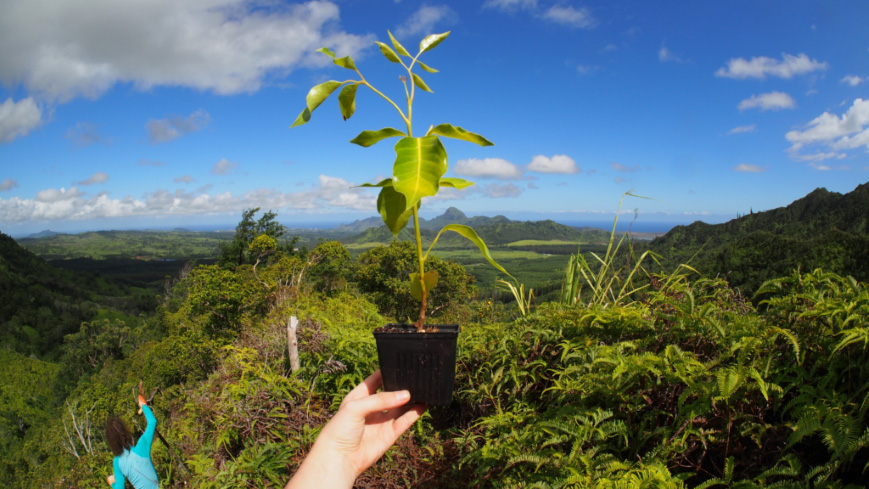
SAFEGUARDING THE FUTURE
The 2017-2018 outplanting campaign was one of the largest outplanting events of any threatened plant species on Kauai. The chosen reintroduction sites represented a broad range of environmental conditions and microhabitats, and ongoing efforts today aim to discover more about the habitat requirements, reproduction biology, and population dynamics of this rare species.
“After outplanting, we wished the Polyscias bisattenuata luck and left them alone for two years without management,” said Julia. “But, in 2020 I received a grant from the Lyon Arboretum which funded the monitoring of the reintroduced saplings,” she concluded. Julia documented GPS coordinates and monitored the survival of the 2017 outplants. Of the reintroduction sites monitored in January 2020, survival rates ranged from 1% to 34%, which is really good considering this is an extremely rare plant whose habitat preference is unknown.
Inspired by Julia’s initial findings, NTBG applied for a larger science support grant from US Fish and Wildlife Service (USFWS) to continue the work together with a large team of researchers and collaborators from USFWS, US Geological Survey and PEPP – the Plant Extinction Prevention Program.
“In order to better understand what determines outplanting success and improve the conservation plan of this species, we will continue extensive monitoring while also adding sampling to investigate the correlation of success with origin and genetics,” said Nina Rønsted, NTBG Director of Science and Conservation, who leads the project together with Julia and NTBG Living Collections Curator Mike DeMotta.
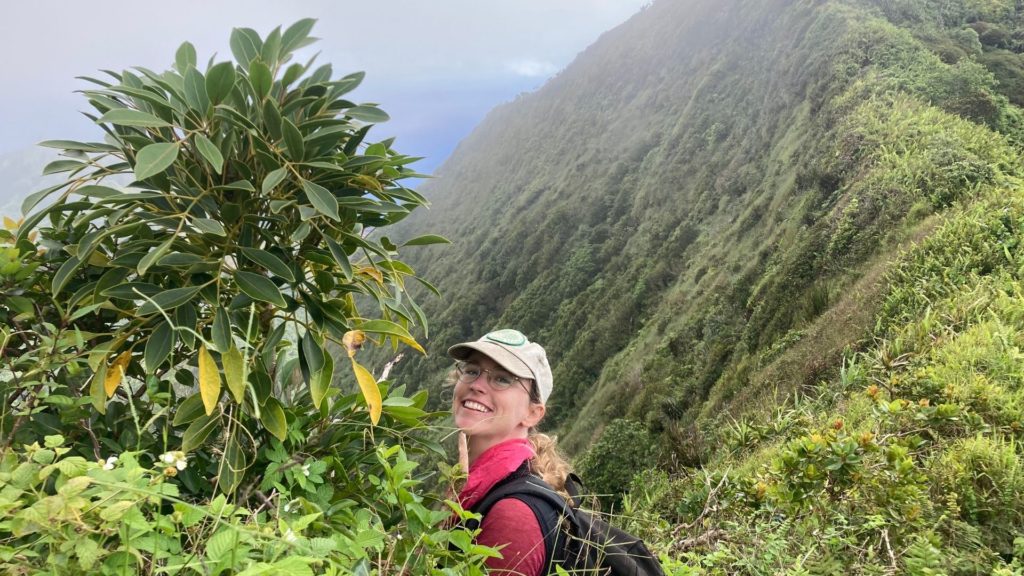
Monitoring of this species continued from November 2021 through January 2022 and approximately 430 plants were recorded alive by Julia, together with a large team of staff, students, and volunteers from both NTBG Living Collections, Science and Conservation, and Limahuli Garden and Preserve remarked Julia. “From the most recent monitoring campaign, we can conclude that most of the loss happened in the first few years. Many saplings are big enough to survive now and we have even observed the first flowering outplants, suggesting natural reproduction is likely to happen, which is really amazing,” exclaimed Julia.
With the success of Polyscias bisattenuata conservation efforts so far, NTBG and collaborators can see hope on the horizon. Additional monitoring and outplanting campaigns are planned, but that doesn’t mean all challenges to the survival of Polyscias bisattenuata have gone. “Rodent predation is still a threat and we need to establish fencing or other protective measures before much more outplanting can be done,” noted Nina.
Until then, it’s hard not to feel hopeful about what the future holds for Polyscias bisattenuata.
“The experience of participating in the planting and monitoring the success of the reintroduction of the ohe mauka has given me hope that with sufficient effort and subsequent rounds of reintroduction and monitoring, this unique component of Kauai’s forest mosaic might be saved from extinction.”
“The experience of participating in the planting and monitoring the success of the reintroduction of the ohe mauka has given me hope that with sufficient effort and subsequent rounds of reintroduction and monitoring, this unique component of Kauai’s forest mosaic might be saved from extinction,” said Julia
Back on that steep montane slope, the tradewinds sound just a little more musical through the clattering leaves of Polyscias bisattenuata trees and carry an unmistakable note of strength and hope.
Hear more about this project directly from our scientists in our webinar: Conservation and Restoration of Endangered Trees.
About NTBG
National Tropical Botanical Garden (NTBG) is a not-for-profit institution, dedicated to discovering, saving, and studying the world’s tropical plants and sharing what is learned.
Our network of five botanical gardens, preserves and research facilities encompasses nearly 2,000 acres with locations in Hawaii and Florida. Thousands of species from throughout the tropical world have been gathered, through field expeditions, collaborations with other institutions and researchers, to form a living collection that is unparalleled anywhere.
Our collection includes the largest assemblages of native Hawaiian plant species and breadfruit cultivars in existence. Many of the species in our collections are threatened and endangered or have disappeared from their native habitats. In our preserves and beyond our gardens, NTBG is working to restore habitats and save plants facing extinction.
Our gardens and preserves are living laboratories and classrooms for staff scientists, researchers, students and visitors from all over the world. You’re invited to be a part of our team. Help us save plants and make a difference by joining as a member! Sign up by May 31, 2022, for a chance to win a VIP experience.
Acknowledgments
Dr. Sandra Knapp Awarded 2022 David Fairchild Medal for Plant Exploration
Kalaheo, Hawaii (April 5, 2022)—The National Tropical Botanical Garden (NTBG) has awarded Dr. Sandra Knapp, a tropical botanist and researcher at the Natural History Museum, London the 2022 David Fairchild Medal for Plant Exploration. The medal has been awarded annually since 1999 to individuals who have demonstrated service to humanity in exploring remote areas of the world to advance plant discovery, the cultivation of new and important plants, and the conservation of rare or endangered plant species.
The medal was presented to Dr. Knapp on April 6 in a ceremony at The Kampong, NTBG’s garden located in Coconut Grove, Florida and former residence of renowned explorer and botanist Dr. David G. Fairchild.
Dr. Knapp is best known as one of the world’s leading specialists in the taxonomy, crop diversity, and ethnobotanic uses of the Solanaceae, a family that includes tomatoes, potatoes, eggplants, tobacco, and mandrakes.
Born in Oakland, California and raised in New Mexico, Sandra Knapp was introduced to field botany as an undergraduate at Pomona College in the 1970s. It only took one visit to the desert with a microscope in hand for her to realize that she wanted to dedicate her life to fieldwork and the study of plants. Sandra Knapp went on to study at the University of California, Irvine (’78-’79) before earning a PhD. from Cornell University (’85). Dr. Knapp’s doctoral dissertation was titled A Revision of Solanum section Geminata. She studied under the late Dr. M. D. Whalen who she thanks for first suggesting that she study Solanum.
Upon graduating, Dr. Knapp taught biology, taxonomy, and phytogeography as a teaching assistant at Cornell before embarking on four decades of field research, primarily in Central and South America as well as in China and Uganda.
In 1992, Dr. Knapp joined the Natural History Museum as a senior scientific officer in the Botany Department. Her career with the museum has continued and evolved from research botanist to individual merit researcher (level 2) today. She has also served as head of the museum’s Plants Division (2012-2019).
Over the course of her career, Dr. Knapp has contributed to Flora Mesoamericana and is the founder and curator of the online resource Solanaceae Source. She has described over 100 new plant species, authored more than 270 peer-reviewed scientific articles, and written, edited, or contributed to 30 scientific and popular books about plant exploration, discovery, and botany. She is the author of the forthcoming book In the Name of Plants: From Attenborough to Washington, the People Behind Plant Names (University of Chicago Press). From 2018 to 2022, Dr. Knapp has served as the president of the Linnean Society of London.
Dr. Knapp has broad experience as a field explorer, research botanist, taxonomist, educator, and active member of numerous academic and scientific bodies including appointments to the Botanical Society of Britain and Ireland, Fauna and Flora International, the Field Museum of Natural History, the Harvard University Herbaria external review board, and others.
She is also an enthusiastic science communicator, editor, and author who believes that all people have the potential to be naturalists by being keen observers and thinkers engaged with the natural world and their own surroundings.
As an avid public speaker, Dr. Knapp has lectured widely for public and professional audiences and on panels for the United Nations Climate Conference, the Natural History Museum, the Royal Institution, the BBC, and other scientific and educational venues.
Dr. Knapp is a firm believer in initiating conversations about science and being open-minded to new ideas and different perspectives. She says science communications is about “having a conversation and arriving sometimes at a place that you the scientist didn’t think you would arrive at.” The important thing, she says, is to start that conversation.
One of Dr. Knapp’s colleagues, Dr. Jan Salick, senior curator emerita with the Missouri Botanical Garden, described her as a “most valued friend.” She recalled meeting Sandra Knapp while both were
attending graduate school at Cornell University. On one occasion, Dr. Salick invited Dr. Knapp to join her on a collecting expedition in the jungles of the Amazon headwaters. Dr. Salick recalls how despite both of them being pregnant at the time, they paddled on rafts and dugout canoes down Rio Palcazú and its tributaries, interviewed shamans and Indigenous women about traditional knowledge of cassava (yuca), and how Dr. Knapp found a new species of Solanum on that same trip.
Dr. Knapp was nominated for the Fairchild Medal by NTBG’s science and conservation director Dr. Nina Rønsted who described her as “passionately and deeply engaged in a plethora of areas and international organizations devoted to plant systematics, fieldwork, crop science, and more.”
Dr. Rønsted called Dr. Knapp an “inspiration to a generation of scientists, students, practitioners, and plant enthusiasts,” adding that she has contributed to a greater understanding of the importance of saving the world’s plants.
Upon learning that she had been named as recipient of the 2022 Fairchild Medal, Dr. Knapp admitted her surprise, calling the award an “incredible honor.”
The David Fairchild Medal for Plant Exploration is named for one of the most influential horticulturists and plant collectors in American history. Dr. Fairchild devoted his life to plant exploration, searching the world for useful plants suitable for introduction into the country. As an early “Indiana Jones” type explorer, he conducted field trips throughout Malaysia, Indonesia, Sri Lanka, China, Japan, the South Pacific, the Caribbean, South America, the Middle East, and East and South Africa during the late 1800s and early 1900s.
These explorations resulted in the introduction of many tropical plants of economic importance to the U.S., including sorghum, nectarines, avocadoes, hops, unique species of bamboo, dates, and varieties of mangoes.
In addition, as director of the Office of Foreign Seed and Plant Introduction of the U.S. Department of Agriculture during the early 20th Century, Dr. Fairchild was instrumental in the introduction of more than 5,000 selected varieties and species of useful plants, such as Durum wheat, Japanese varieties of rice, Sudan grass, Chinese soybeans, Chinese elms, persimmons, and pistachios.
Fairchild and his wife, Marian Bell Fairchild, daughter of inventor Alexander Graham Bell, purchased property in South Florida in 1916 and created both a home and an “introduction garden” for plant species found on his expeditions. He named the property “The Kampong,” the Malay word for “village.”
The tropical species Fairchild collected from Southeast Asia in the 1930s and 1940s are still part of the heritage collections of The Kampong. The property is the only U.S. mainland garden owned by NTBG, which has four gardens and five preserves in Hawaii. The organization is dedicated to conservation, research, and education relating to the world’s rare and endangered tropical plants.
Media contact: media@ntbg.org
National Tropical Botanical Garden (ntbg.org) is a not-for-profit, non-governmental institution with nearly 2,000 acres of gardens and preserves in Hawaii and Florida. The institution’s mission is to enrich life through discovery, scientific research, conservation, and education by perpetuating the survival of plants, ecosystems, and cultural knowledge of tropical regions. NTBG is supported primarily through donations, grants, and memberships.
Interview with Dr. Sandra Knapp, recipient of the 2022 David Fairchild Medal for Plant Exploration
Since 1999, the National Tropical Botanical Garden has recognized exceptional botanists, horticulturists, and explorers by awarding them the David Fairchild Medal for Plant Exploration.
On April 6, 2022, Dr. Sandra Knapp of the Natural History Museum (London), will be presented with the medal at a ceremony at NTBG’s Miami garden, The Kampong. Dr. Knapp is best known as a specialist in the taxonomy, crop diversity, and ethnobotanic uses of the Solanaceae, a family that includes tomatoes, potatoes, eggplants, tobacco, and mandrakes.
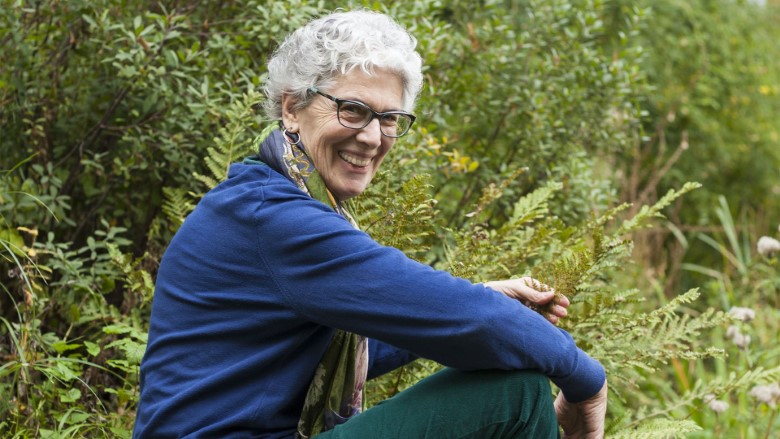
Dr. Knapp has over four decades of experience botanizing in Central and South America as well as Africa and China and is a contributor to Flora Mesoamericana and the founder/curator of Solanaceae Source. She has described over 100 new plant species, authored more than 270 peer-reviewed scientific articles, and has written, edited, or contributed to 30 scientific and popular books about plant exploration, discovery, and botany. From 2018 to 2022, Dr. Knapp served as the president of the Linnean Society of London.
Dr. Knapp spoke with NTBG in January from her home in London. An edited and condensed version of that conversation follows below.
NTBG: Congratulations on being named recipient of the David Fairchild Medal for Plant Exploration.
Sandra Knapp: Thank you. It was a real surprise. I thought, “What? This is crazy! There must be some mistake.” But it’s an incredible honor because David Fairchild was an extraordinary person.
You’ve spent much of your career studying Solanaceae. Why have you focused on this group of plants?
At Cornell University, my major professor Michael D. Whalen said I should study the genus Solanum and go to the tropics. I wanted to go to the desert, but I went to Costa Rica and that was it. I was completely hooked. I fell in love with the tropics and the wonderful, massive, incredible diversity that’s all around. I started looking at solanums and there were lots that didn’t have names but they were all clearly different. Nobody had worked on the taxonomy of them so I thought, “OK, maybe I can do Solanum.” There was no looking back. I just got deeper and deeper into Solanum.
What exactly attracted you to this family of plants?
The Solanaceae are amazing because they’re well-known both as things that we love to eat— tomatoes, potatoes, eggplants—but also as plants that can kill us, like nightshades and tobacco. They are inextricably linked with people. It’s just fascinating because people have found uses for so many Solanaceae. You can pick fruits and eat them. But all of these poisons, medicines, and psychoactive drugs—that requires a certain amount of experimentation which is pretty dangerous, really. It is absolutely fascinating that within this one small family there are all these uses.
The other thing that is amazing about Solanaceae is that it’s a medium-sized family that only has about 4,000 species, it’s not a monster like the daisies or the orchids. But half the species diversity of the family is composed of a single genus, Solanum, which is one of the top ten most species-rich genera of flowering plants. That’s pretty amazing. It’s one of maybe ten or fifteen genera which have more than a thousand species. Solanum, at our current estimate, will soon have 1,250 species. One of the things that grabbed me is—why are there so many of these species of Solanum? To even begin to answer that question, you need to figure out what the species are and nobody had done that since the 19th century. People keep asking “haven’t you figured it out yet?” My answer is, no, we’re getting there though.
Can you talk about the loss of biodiversity as it relates to Solanaceae?
The majority of species diversity of Solanum is in South America. So you would expect that the highest speciation rates, the highest diversification rates, would be there as well. Well, it turns out it’s the exact opposite. The highest diversification rates are in places like Australia and Africa, and they seem to be correlated with the Miocene aridification of those continents. The changing landscape helped Solanum in those areas invade new territories and have explosive speciation.
Climate change and environmental change can work both ways. Aridification is often bad for plants, but it depends on the plant. The lineage of Solanum that made it to Australia is very dry- adapted and it just went berserk and diversified. Still not as many species as in South America, but they’re all each other’s closest relatives. Then there are other species which have very narrow ranges, in the páramos and other high areas in the Andes, where the tree line is going up and so those species are at risk from climate change. But actually, the biggest driver of change is us, it’s humans—our modification of the landscape.
What about the loss of traditional plant knowledge?
A lot of the traditional knowledge about Solanaceae is actually global traditional knowledge now because these are world-wide crops and much is widely known. There is traditional knowledge about Solanaceae that I know nothing about. I am sure that there is also traditional knowledge that is held by very few people. But as Indigenous peoples become threatened themselves, and as languages become threatened as well, a lot of that plant knowledge is bound up in the language and when language becomes at risk, then the knowledge becomes at risk.
The coronavirus pandemic has had a profoundly harmful impact on people around the world. It has also disrupted so much of our personal and professional lives. Can you find any kind of silver lining in this?
One of the silver linings is that with regards to herbaria and collections, it’s becoming clearer that if your collections are online, people will use them. That’s always kind of been true, but when we’re all stuck at home, trying to do our work at home, having literature online through the Biodiversity Heritage Library and having herbarium specimen images online is an absolute godsend. That didn’t come with the pandemic, but I think the pandemic has provided impetus for people to accelerate digital access.
Regarding the pandemic, as it relates to the understanding and the importance of preserving plants, how do you make a connection?
I actually think that the pandemic, and the fact that it is the result of an interaction between humans and the natural world, makes it ever more important that we study, understand, and preserve the natural world so that there are places for nature to thrive. Human beings are an invasive mammalian weed. We are the epitome of a weedy species. We go everywhere. We grow everywhere. We reproduce fast. We can adapt to all kinds of climates and places. We’re the most successful weed on the planet. If you think about human beings as a weed, weeds are a threat. Human beings are a threat. And when weeds come in contact with particular pests or can pick up genes that are problematic, then it becomes a problem. The same is true with viruses and us. This is hardly a surprise, to be honest.
Do you think scientific organizations, botanical gardens, museums, or the media in general are doing a good job of communicating the importance of science, and plants in particular?
I think this is one of the things that we all struggle with, and all of us are trying and doing as best we can, but I think there are many things we could do better. One of those is having a conversation rather than just giving information, because bringing people along is about acknowledging that they have views that might be different from our own and being open to that conversation. One thing that often happens in science education is people think of it as a one-way street. “We will communicate our science to this public and then they will understand.” Well, it doesn’t work like that. It’s much more about having a conversation and arriving sometimes at a place that you, the scientist, didn’t think about at the onset.
Also, being willing to say that you’re wrong or that you don’t understand or don’t know is crucial. I think as scientists—and I know I do this—it’s almost as a knee-jerk thing to avoid this, I worry about saying something because I might be wrong. But actually, that doesn’t matter. The really important thing is to start a conversation, because that’s where you begin to look at the world through somebody else’s eyes and that then changes your own world view.
Science itself can’t exist in a vacuum because science is part of society. It doesn’t exist as separate from society. Some people might consider advocacy about climate change to be political. What’s considered political is really, in a way, a matter of opinion. Scientists are part of society, and they need to be concerned with societal issues. And sometimes it can be quite uncomfortable.
Can you talk about how you communicate science at the Natural History Museum?
I am proud of my own institution for creating a strategy which is about creating advocates for the planet. Yes, we do good science and yes have great collections—but our mission is to create advocates for the planet. We use our collections and the science we do with them to do that. People who are vocal supporters of the natural world is our long-term goal.
You mean to get everybody involved?
Everybody’s a natural historian, really. Everybody is interested in pebbles and things that they pick up as they walk around their neighborhoods. But it can be frowned upon in scientific circles because it’s not “scientific.” But actually, it is scientific. If you go out in the forest and collect a plant, you make a hypothesis that it might be ‘species X’ and then you use evidence to disprove that or perhaps that evidence supports your idea. Somehow this has been lost, the fact that natural history—just observing and documenting the world around us—is hypothesis-driven.
You are just the third woman to receive the Fairchild Medal. What are your thoughts on this imbalance?
I’ve been compiling the gender statistics for the medals for the Linnean Society, it’s actually quite shocking. Mostly men get nominated so it’s not really surprising that medals often go to men, but why is that? I don’t know. The times are changing. I am the third female president of the Linnean Society which dates from 1788 so I am the 53rd president, or something like that. But only the third woman, but my successor is also a woman, so change is happening. What I think will be really interesting is if we can look back in twenty years’ time and see if the graph of medal awards changes. What we should be is fifty-fifty, really. Excellence doesn’t have gender.
Can you talk about how field work has changed since you first started as a botanist?
People don’t go in the field by themselves anymore. We go into the field with a colleague or with our local counterparts, say from an institution from South America or in Africa. I think that’s a really good thing because when you do, relationships begin with local scientists from those countries which then levels up science and allows people to share in a much more equitable way than happened in the past. Parachute science, where collectors and explorers went in and took, as happened in colonial times, certainly should be a thing of the past.
Last question. Do you think the botany and natural history of Central and South America offer an avenue for increased interest and a greater understanding for that part of the world?
Yes, the Americas are an absolutely extraordinary set of continents and understanding their sheer diversity is part and parcel of understanding the world. Many of our crops come from Eurasia, but others are American in origin. Thinking about centers of crop plant origin is interesting in this context because if you look at crop plants that are essential to diets in the United States, they’ve all—except for the sunflower—come from outside of North America. If you took everything that didn’t originate in the United States, you’d be left with very little; David Fairchild had a real hand in this diversity of crops in the United States that now seems to be integral to US agriculture.
Globalization is often perceived as a really bad thing, but it has gotten us to where we are and it has been happening for a long time—long before European colonization of the Americas. For me it presents a huge and uncomfortable paradox. How can we accept the fact that the foods that we eat, the food that we love, the foods that we think of as being indigenous to ourselves, actually come from somewhere else, but then, at the same time, not accept people from those other places. Why is it “food good, people bad”? It’s very Animal Farm-y and kind of Orwellian in a slightly odd way.
Our diets across the globe are becoming much more diverse so we’re eating lots of different things. But we’re all, across the world, eating much more of the same things. So regionalization of diets is disappearing but we’re all eating more different things in part because of the ease of transport and global markets and all this other stuff. It may all change if we’re unable or unwilling to transport snow peas from Kenya or cherries and apples from Chile in the non-apple season for the northern hemisphere, as global events and our concern for the climate coincide.
How NTBG gardens fight invasive species in Hawaii
February is Invasive Species Awareness Month in Hawaii, a time to consider the threat posed to Hawaii’s unique and irreplaceable flora and fauna. The Hawaiian Islands are famous around the world for the high level of endemism—plants and animals found only in a specific location and nowhere else. Of Hawaii’s roughly 1,300 native plants, 90% of them are endemic to the Hawaiian Islands. Many are single-island endemics, for example, found only on Kauai or only on Maui. Others are restricted to a single valley, ridge, or other small geographic area.
Throughout the last century or two, the number of humans and introduced plants and animals have rapidly and dramatically altered ecosystems and affected species to the point that 85% of Hawaii’s land has lost its native flora.
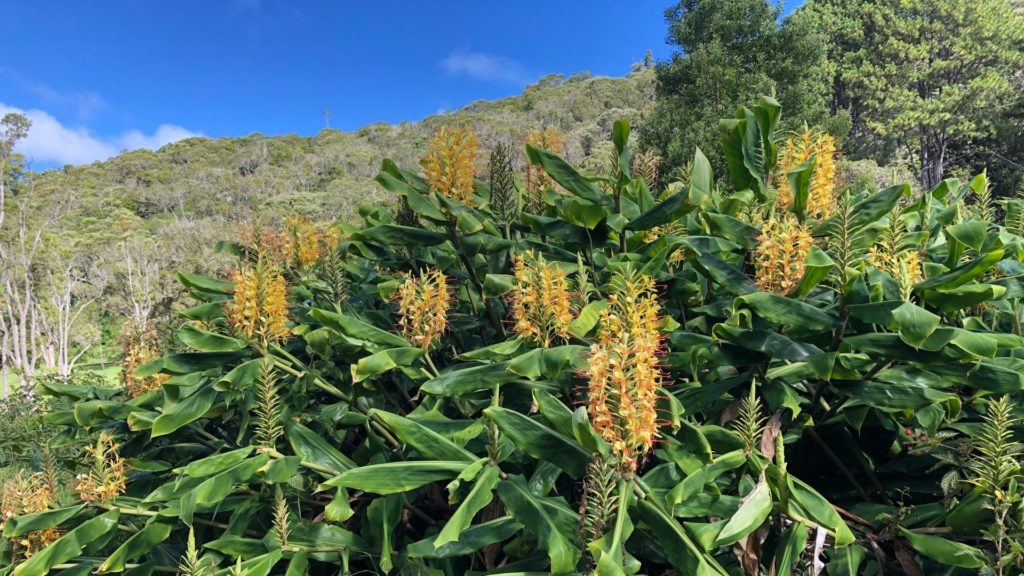
Invasive species continue to take an enormous toll on Hawaii’s natural world. Everything from Himalayan ginger and guinea grass to Coqui frogs, little fire ants, feral ungulates, rats, slugs, and domesticated animals are over-running Hawaii’s vulnerable native flora and fauna.
NTBG is a not-for-profit organization dedicated to plant discovery, scientific research, conservation, and education. Our network of five botanical gardens and four preserves serve as living laboratories and our team of staff and scientists perform an important role in the fight against the damaging effects of invasive species in our communities and native ecosystems. Our efforts to slow and stop the spread of invasive species begin at home in our gardens and preserves throughout Hawaii and Florida, and make a global impact.
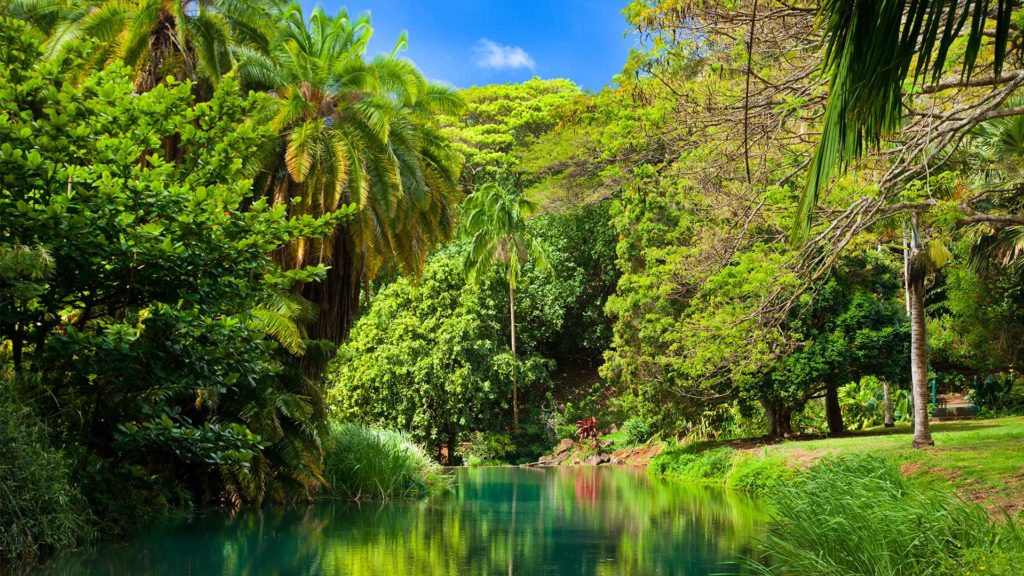
Kauai Island (McBryde, Allerton & Limahuli Gardens)
Our extensive collections of palms, Rubiaceae, Heliconias, orchids, and many others have been wild-collected by botanists and biologists from throughout tropical regions around the world and transported to our gardens to research, cultivate and thrive. Living collections staff and volunteers monitor our collections regularly to identify species for invasive tendencies to ensure these introduced plants do not become harmful to the surrounding environment. Once identified as invasive, species are deaccessioned and removed.
Threats from outside NTBG’s Living Collections also exist. Invasive species often make their own way into our gardens and it can often be hard to recognize their invasive tendencies among the veritable botanical ark of tropical flora. The Kauai Invasive Species Committee (KISC) assists with monitoring the gardens and have so far helped to identify and remove two taxa that were invasive to Lawai Valley. These taxa have been added to their database for further monitoring.
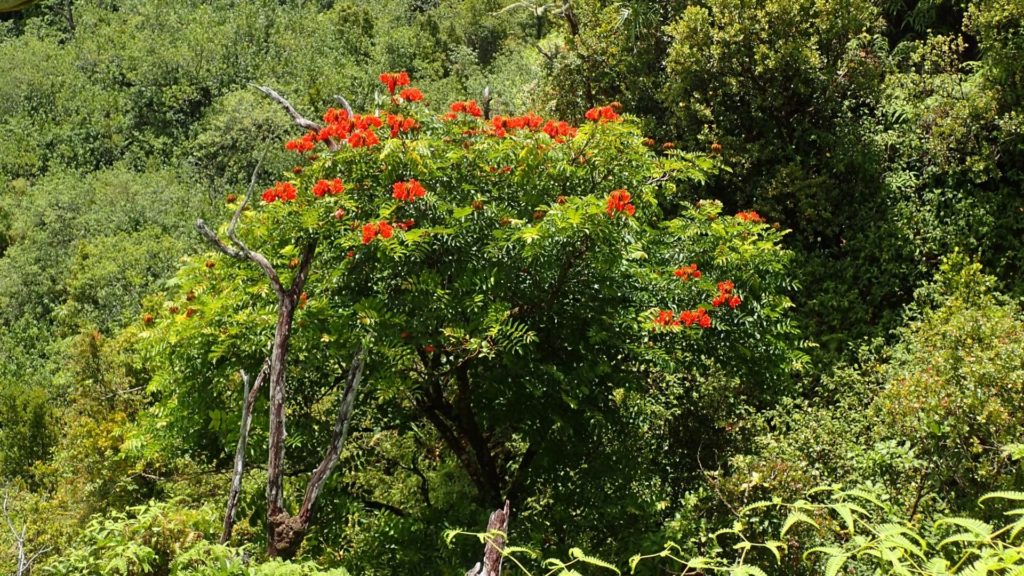
Maui Island (Kahanu Garden)
Invasive species like nutsedge, inkberry, turkeyberry, honohono, and African tulip trees present an ever-growing threat to Kahanu Garden’s collection of Hawaiian and Pacific heritage and agricultural plants as well as the Piilanihale Heiau cultural site. Each year Kahanu Garden staff remove thousands of young plants that arrive as airborne seeds and quickly set deep roots, leave seed banks in the soil, and require months or years of active management. This requires an ever increasing commitment by staff and volunteers to keep the aggressive invasive plants in check.
In the Field
In addition to KISC, NTBG scientists work with agencies like Hawaii Department of Agriculture and the Department of Land and Natural Resources to provide field observations and reference collections that can be used for specimen identification as well providing population and occurrence information on invasive species.
When our botanists are in the field and observe an invasive plant they’ve never seen on the island before, they document the observation and notify the KISC Early Detection Program. These early detections can mean the prevention of a new invasive species on the island from becoming established.
Conservation of threatened and endangered flora is our highest priority, but stemming the spread of invasive species and the threats they pose to native ecosystems is a big job we can’t do alone. In addition to our team, we rely on dedicated volunteers and curious visitors to help save plants and people. You can help by planning a visit to an NTBG garden, volunteering your time, or making a donation.
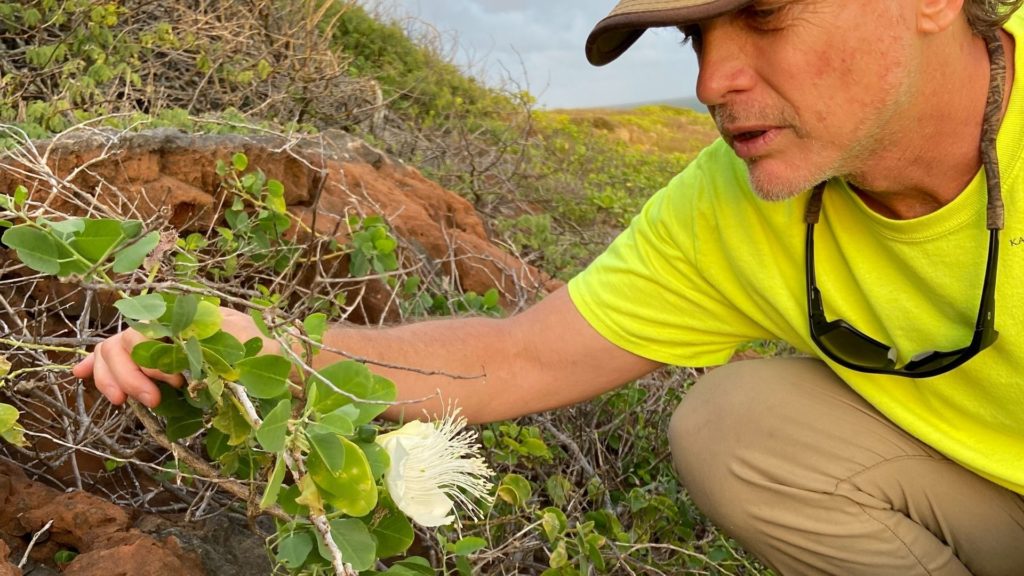
Want to make a difference in your own community? Learn more about your native ecosystem and the plants that keep it healthy and thriving. Don’t miss our upcoming webinar spotlighting the fight against invasive species and efforts to propagate native plants for horticulture trade. Register today.
Discovering new forms of life in the Limahuli Preserve
Little Wing: Discovering new forms of life in the Limahuli Preserve
By Jon Letman, Editor
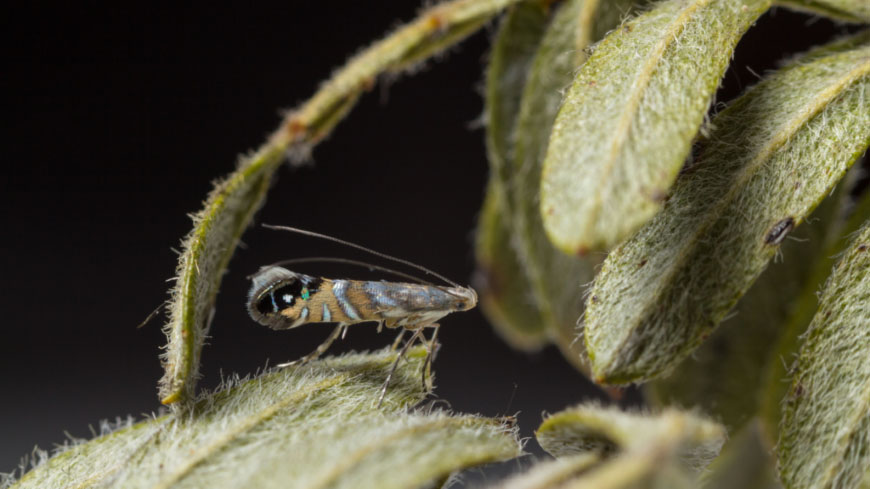
The Hawaiian Islands are often associated with big, dramatic natural events (volcanic eruptions, powerful ocean swells) and large, complex ecosystems (dense tropical forests, dynamic coastlines), but it’s Hawaii’s earliest, smallest, least known creatures that offer one of the most important lessons about evolution, diversity, and interdependence.
Hawaii is home to a genus of micromoth called Philodoria which is believed to have first reached the Hawaiian Islands 21 million years ago (some 8 million years before Hawaiʻi’s largest plant clade, the Lobeliads). Like the larvae of some beetle and fly species, Philodoria are leaf miners. They’re also extremely small — about as long and as thick as a human eyelash.
When the tiny moth lands on the leaf of its host plant, it lays eggs which produce microscopic caterpillars that burrow through the leaf, forming tiny tunnels and caverns as they eat their way through the tissue of their thin, green home. There they grow into larvae safely sheltered from predators like parasitoid wasps which are known to use Philodoria larvae as a host.
After several weeks, the caterpillar grows until it pupates, emerging from the leaf in a cocoon before metamorphosizing into a moth. The whole process takes up to six weeks.
Survival of the Philodoria, which are endemic to Hawaii, depends on the moth-host plant relationship. If the host plant goes extinct, it stands within reason that the moths that depend on them will disappear too.
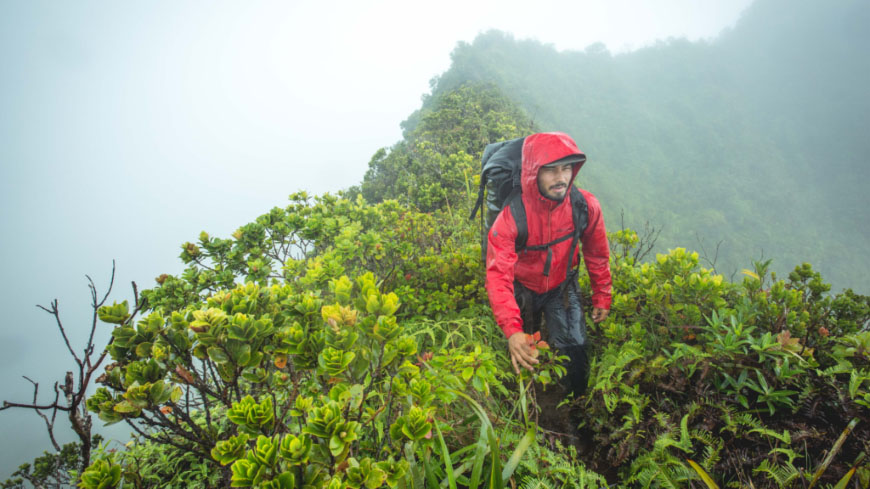
Barely known, rarely seen
Earlier this year, researchers from Osaka Prefecture University and the Florida Museum of Natural History (University of Florida) published a monograph (in depth study) with names, descriptions, and the conservation status of 13 new Philodoria species and their host plants. In total, researchers confirmed 51 Philodoria species, many of which hadn’t been seen in over a century, and 13 of which were new to science.
Among the newly described moths, Philodoria limahuliensis, is known from a single location in the Upper Limahuli Preserve. Biologist Dr. Chris Johns, a co-author of the paper, first saw the moth in 2016. Johns, a self-described micromoth enthusiast, says even this tiny creature plays an important role in the ecosystems they inhabit.
Studying Philodoria can help us understand many other forms of life, including our own, says Johns. “Philodoria moths can teach us a lot of things about life on this planet and evolution.”
When Johns teamed up with entomologist Dr. Akito Kawahara at the University of Florida in 2013, Philodoria hadn’t been studied closely in over a century and their conservation status was poorly understood. Johns, who had previously done conservation work in Hawaiʻi, jumped at the chance to join Kawahara for what would be a five-year study searching for some of the world’s smallest moths inside of the world’s rarest plants.
Over the course of six trips to six Hawaiian islands, Johns partnered with local scientists to search for Philodoria living among host plants including ohia (Metrosideros spp.), mamaki (Pipiturus spp.), and Hesperomannia, an extremely rare native member of the sunflower family. As a genus, Philodoria are diverse feeders though they tend to develop a very specific host plant relationship. One species lives among Wollastonia integrifolia, a coastal plant, while another lives within the greenswords (Argyroxiphium grayanum) of west Maui’s high elevation bogs where it was described as Philodoria wilkesiela by English entomologist Lord Thomas de Grey Walsingham in 1907. Johns found the same moth in that exact location in 2013. Philodoria’s historical range has been well-documented, Johns said, but it was difficult to find intact habitat that hadn’t been developed or entirely replaced by invasive species.
In 2015, based on Kawahara’s past collaboration with NTBG staff, Johns was introduced to then-NTBG field collector Natalia Tangalin, from whom he learned of known leaf miners suspected to be Philodoria in the Limahuli Valley. That year Johns and Tangalin helicoptered to a weatherport (in the Upper Limahuli Preserve to provide shelter for multi-day fieldwork) in the Upper Limahuli Preserve. Based on a hunch from Tangalin, they hiked down to a place where a small stream flows into a waterfall. Just above that spot, a lone shrub — Hibiscus waimeae subsp. hannerae — grew out of a sidewall in the stream. There they collected ten moths which Johns believes were unique to the location and to date is the only known habitat of what has been named Philodoria limahuliensis. Johns says P. limahuliensis is one of the rarer species but a second Philodoria species was found in Limahuli Valley living with its host ohia (Metrosideros sp.).
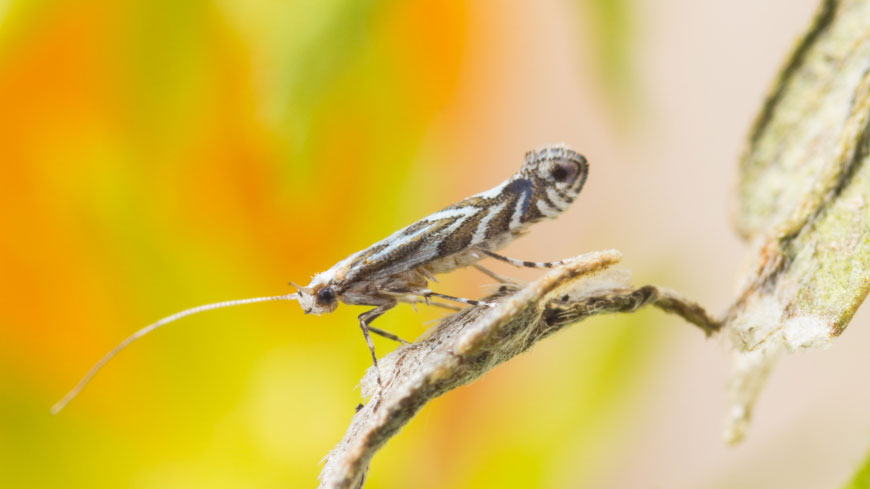
Why does it matter?
Some might question the significance of finding a tiny moth on a Critically Endangered plant in the back of a remote valley. Johns explains how such a discovery sheds light on the origin and age of organisms in Hawaii, a place that has informed much of our scientific understanding of evolution on islands. Philodoria may be the oldest extant lineage in the archipelago. “As far as things that remain alive in Hawaii today, Philodoria seems to be one of the first to get here,” Johns says.
And because, like the Galapagos, Hawaii is a storied natural laboratory for evolution, identifying a new micromoth found nowhere else on earth opens a new chapter of scientific inquiry and can address the same questions asked about other organisms, offering a new perspective and more comprehensive understanding of evolution and life on earth.
To study an insect as small as Philodoria, scientists must go to great lengths to identify and understand how species are related to one another. One method of identification is a morphological examination of the genitalia of each species which is challenging given the moth’s size. Another technique is the molecular analysis of tissue to compare DNA among differing species.
Using phylogenetics and a technique called ancestral reconstruction (DNA analysis to understand how species are related to one another), Philodoria researchers have gained new insights to what ancient moths might have been feeding on when they inhabited now sunken Hawaiian Islands that predated the islands we know today. Johns says it’s likely those ancient host plants belonged to Ebenaceae, Malvaceae, and Primulaceae. “That paints a really interesting picture of something we didn’t know before about this place,” Johns says.
A treasure trove of discovery
Even for the non-scientist, Johns says people are drawn to anything that creates a deeper, more complex picture of a place revered for its natural beauty. “What is it that comprises that natural history?” he asks. “It’s biodiversity. Who doesn’t love a new angle to a beloved story or character?”
The discovery of Philodoria limahuliensis near a small waterway that feeds into the Limahuli Stream underscores the importance of protecting and studying this pristine riparian habitat. The unique conditions found along the stream led to an NTBG-led project to restore the health and function of the stream. Selective tree trimming, outplanting, and extensive monitoring are expected to benefit native flora and fauna while helping preserve whole-ecosystem biodiversity in the Limahuli Valley.
Having found and identified Philodoria limahuliensis in the Limahuli Valley, Johns was elated to have had the chance to work in a native forest that remains largely intact and relatively weed-free. He calls Limahuli “among the very best of privately held land with robust environmental protection” in Hawaii.
“NTBG has something really, really, really special,” Johns says. “In terms of moth diversity and the potential for future discovery and protection… Limahuli is one of the best places. I think the work that’s being done there is top notch.”
NTBG completes the Flora of Samoa
By Dr. David H. Lorence, Senior Research Botanist
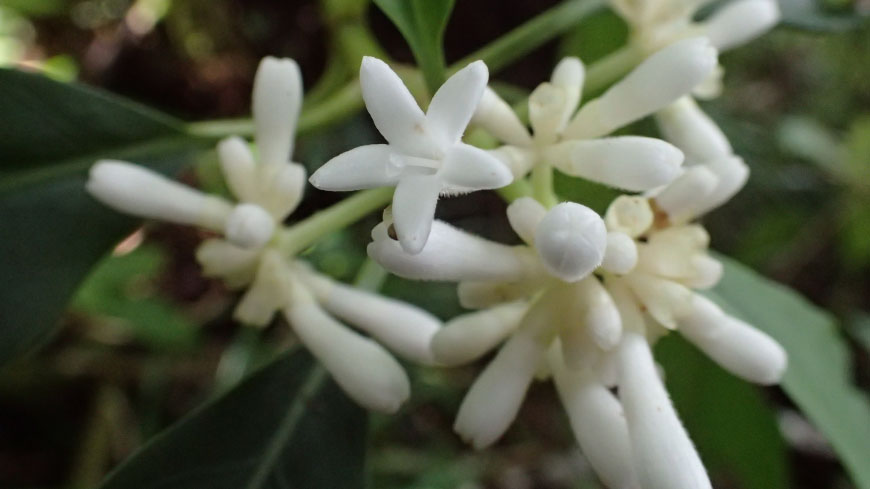
The saga of the Flora of Samoa began on January 16, 1968, when W. Arthur (Art) Whistler arrived in Samoa as a Peace Corps volunteer. Known locally as Pisikoa, Peace Corps volunteers were often assigned to teach in host country schools, and Art taught biology in Samoa for three years. With a master’s degree in botany, Art soon developed a keen interest in Samoan plants. One year after his Peace Corps stint ended, Art returned to pursue botanical collecting in earnest, eventually botanizing on every island in the archipelago. For the next half century, Art visited Samoa every year but one. His 4,900 collections of herbarium specimens include over 90 percent of the known flowering plants and ferns of Samoa.
Art’s first set of specimens are stored at the National Tropical Botanical Garden’s herbarium (known as PTBG based on Pacific Tropical Botanical Garden) with duplicates (especially early collections) sent to many other herbaria, including the Bishop Museum in Honolulu, Royal Botanic Gardens Kew, and the Smithsonian Institution.
After earning a PhD in botany in 1979, Art met Dr. William Theobald, NTBG’s former director, who offered him the position of ethnobotanist which he held from 1983 to 1992. Art also lectured in botany at the University of Hawaii and, for many years, worked as an independent botany consultant in Hawaii and throughout the Pacific. Art published numerous articles and books on Pacific botany and ethnobotany and always dreamed of publishing a Flora of Samoa that would serve as a definitive compilation and identification guide.
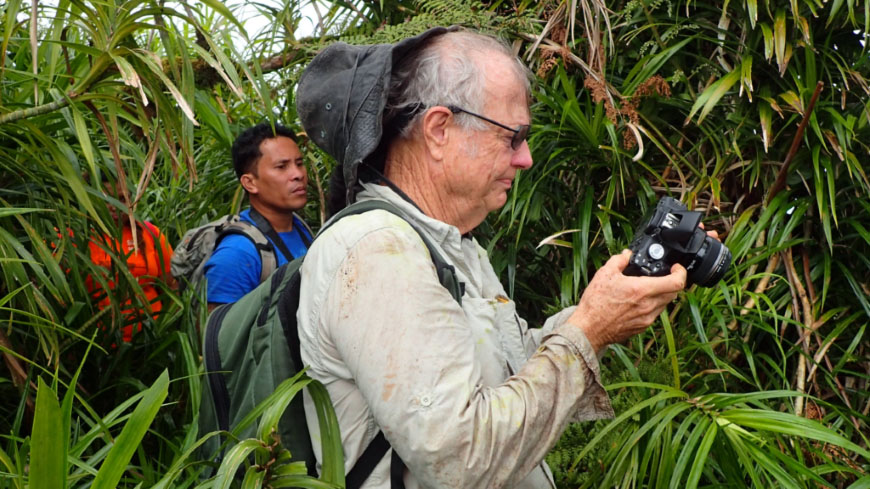
In 2015, NTBG commissioned Art as a McBryde Fellow to prepare a written Flora of Samoa for publication. In what was to be the culmination of a career dedicated to bringing knowledge of the flora and conservation by local communities to a scientific audience, Art had nearly completed the flora’s manuscript, but passed away in April 2020 from Covid-19 complications before it could be finalized.
Following this tragic and unexpected loss, Dr. Warren Wagner, curator of botany with the Smithsonian Institution, and I agreed we would complete the final scientific editing and updating of the manuscript to ensure the flora was published.
Racing to save knowledge
Publication of the Flora of Samoa is urgent as the plant life (particularly in upland ecosystems) is rapidly being lost to invasive plants and animals, land degradation, and threats from climate change. The Flora of Samoa has long been recognized as a priority by the International Union for Conservation of Nature (IUCN) and is consistent with Global Strategy for Plant Conservation goals, including Target 1 of developing an online flora of all known plants.
Samoa is located in the South Pacific, between 500 and 700 miles north and east of Fiji and Tonga. Samoa (formerly called Western Samoa) is comprised of two main islands with the U.S. territory American Samoa to the east. Samoa occupies an important place in the Polynesia-Micronesia biodiversity hotspot, but until now, no published flora existed as a source of essential data for managing and conserving Samoa’s biological diversity.
The Samoan archipelago plays a central role in the Pacific region and the argument for a published flora is strong. First, although the islands’ plants have historically been under-explored, thanks to decades of research by Art, organizational and research infrastructure is in place, and a wealth of preliminary information has been previously published. Additionally, Samoa’s plant diversity is threatened by development, land conversion, and other human activities with Pacific islands and atolls among the first places to be impacted by sea level rise.
Culturally and biologically, Samoa is a cohesive area that would benefit from a single, modern plant diversity resource for studying the effects of climate change. With comparable floras published for Fiji, Hawaii, and the Marquesas Islands, it’s time Samoa had its own printed flora. The completion of this work will greatly aid biologists, ornithologists, vegetation ecologists, and resource managers. A detailed synopsis of the plants is the first step needed for the study and preservation of rare or threatened endemic Samoan species and habitats.
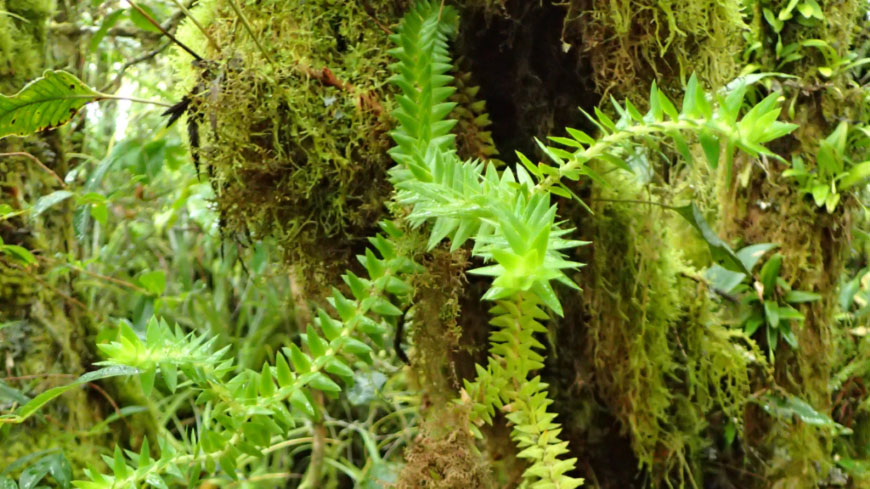
A rich and diverse flora
With 541 native species (186 of which are endemic) and nearly 300 naturalized flowering plant species and 225 ferns and fern allies, Samoa has the second largest native vascular flora in Polynesia after the Hawaiian Islands. About 34 percent of Samoa’s native plants are found nowhere else, compared with 90 and 47 percent endemism among the floras of Hawaii and the Marquesas respectively.
Compared with the flora of Fiji, the Samoan flora is about one-third as large, but they share many floristic affinities due to their relative proximity. The largest family of flowering plants in Samoa is the orchid family (Orchidaceae), with 101 native species. No other Polynesian islands have such a rich orchid flora. Samoa’s second largest family is Rubiaceae, the coffee family, with 47 native and five naturalized species.
NTBG’s role
In 2002 and 2003, NTBG’s Breadfruit Institute director Dr. Diane Ragone and I participated in botanical and ethnobotanical inventory field trips in the National Park of American Samoa for a project funded by the U. S. National Park Service. In 2016, Art accompanied NTBG scientists Tim Flynn, Ken Wood, myself, and two young botanical researchers on a six-week, grant-funded botanical expedition to Samoa’s two largest islands, Savaii and Upolu. Special emphasis was placed on searching for populations of 15 poorly known or “lost” flowering plant species, some not collected in over a century, as well as documenting populations and distribution of additional rare plants. Although the lost species were not rediscovered, two new fern species were. Collaboration with Samoa’s Ministry of Natural Resources and the Environment staff was an essential component of the field work.
From the early 1980s until Art’s untimely passing in 2020, he dedicated himself to studying, collecting, and conserving the plants of Samoa. Art’s manuscript included a considerable number of taxonomic treatments with an emphasis on finalizing all remaining work in recent years. Over those four decades, parts of the original manuscript fell out of sync with other new Pacific botany publications. In the final phase of the peer-review process, Warren and I were in discussion with Art about updates and changes. In Art’s absence, we completed these necessary changes to reflect the latest taxonomic classifications.
Ultimately, the style, format, and content of the manuscript remain in accordance with Art’s wishes and intent. We are deeply honored to get this extraordinary body of research across the finish line, publishing what represents Art’s magnum opus, a definitive publication on the plants of Samoa that will be used for generations to come.
An enthusiastic photographer, Art had selected nearly one thousand plant photos, mostly taken by him, for inclusion in the flora which will also feature over 150 beautiful color figures by Smithsonian illustrator Alice Tangerini, based on Art’s photos. As of the summer of 2021, work on the manuscript is nearly complete and slated for publication by NTBG in 2022 (depending on funding). The published book will comprise nearly 800 pages and represents a milestone in the study of Pacific Island floras as well as the embodiment of Art Whistler’s life-long love for the people and plants of the Samoan Islands.
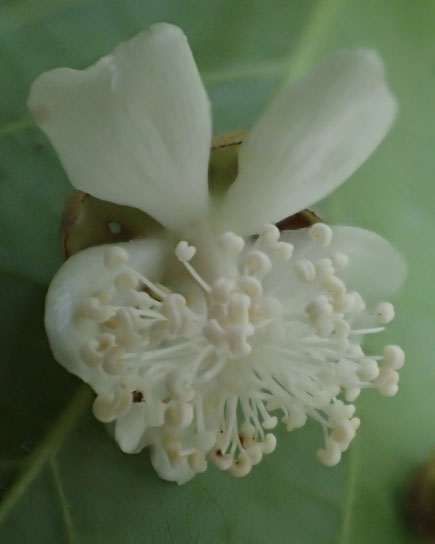
Five Samoan plant species are named for botanist Art Whistler: three members of the Orchid family (Calanthe whistleri, Dendrobium whistleri, and Taeniophyllum whistleri), Hoya whistleri (Dogbane family), and Abutilon whistleri (Hibiscus family), pictured here as photographed by NTBG research biologist Ken Wood on Samoa’s Savaii island where it is endemic to cloud forests above 1,100 m.
NTBG statement on the deaths of Thomas Lovejoy and E.O. Wilson
| December 27, 2021 (Kalaheo, Hawaii) — The National Tropical Botanical Garden (NTBG) is saddened to learn of the passing of two legendary figures in the world of natural science and conservation, Professors Thomas Lovejoy and E.O. Wilson. Both Lovejoy, who died on December 25, and Wilson, who died on December 26, were recognized as pioneers who made sweeping and monumental contributions to the study of nature, and both are credited with popularizing the concept and importance of biological diversity, which they called “biodiversity.” NTBG CEO and Director Janet Mayfield described Lovejoy and Wilson as “towering figures in the world of biology and conservation.” She added, “their life’s work and convictions have been enduring sources of inspiration for us at NTBG. The contributions they have made will continue to guide millions around the world as we grapple with our planet’s most urgent challenges.” NTBG President Charles “Chipper” Wichman praised Lovejoy as a scientist and environmental activist who changed the world saying, “his writing and passion brought awareness to the urgency of saving our planet’s biodiversity.” Wichman worked closely with Lovejoy in securing the International Union for Conservation of Nature’s 2016 World Conservation Congress which took place in Hawaii. Lovejoy played a critical role in securing the Congress, a gathering noted for its diversity, size, and impact. “Tom Lovejoy and E.O. Wilson have inspired a whole culture of dedicated citizens around the globe to continue their visions of a healthy and sustainable planet,” Wichman said. NTBG extends its deepest and most sincere condolences to the families, friends, and colleagues of both Thomas Lovejoy and E.O. Wilson. |
Discoveries of Rare Plant Populations Bring Hope for the Future
Using a combination of modern technology and a wealth of human knowledge and experience, NTBG has been exploring the Pacific, discovering, and saving plants for more than fifty years. As 2021 comes to a close, take a moment to reflect and celebrate some of the exciting rare plant discoveries we made this year.

When you spend a lot of time in one place or ecosystem, your subconscious mind becomes very familiar with what is around you. When we are flying the drone, that subconscious awareness bubbles up and gives us a good idea of where to look for these endangered plants.
Field Botanist, Ken Wood & Drone Specialist, Ben Nyberg on searching for and discovering rare plants
Euphorbia eleanoriae – akoko
Growing on the knife-like edges of Kauai’s iconic cliffs, Euphorbia eleanoriae was down to just one known population with less than fifty individuals. Using drone technology, NTBG discovered new populations in multiple locations from Honopu all the way up to the North Shore of Kauai. Multiple samples were collected for storage and cultivation. The Hawaiians named Euphorbia species, akoko, for it’s white, blood-like sap. Koko is the Hawaiian word for blood. These recent drone related discoveries have led to this species being removed from the Plant Extinction Program list, an encouraging development.
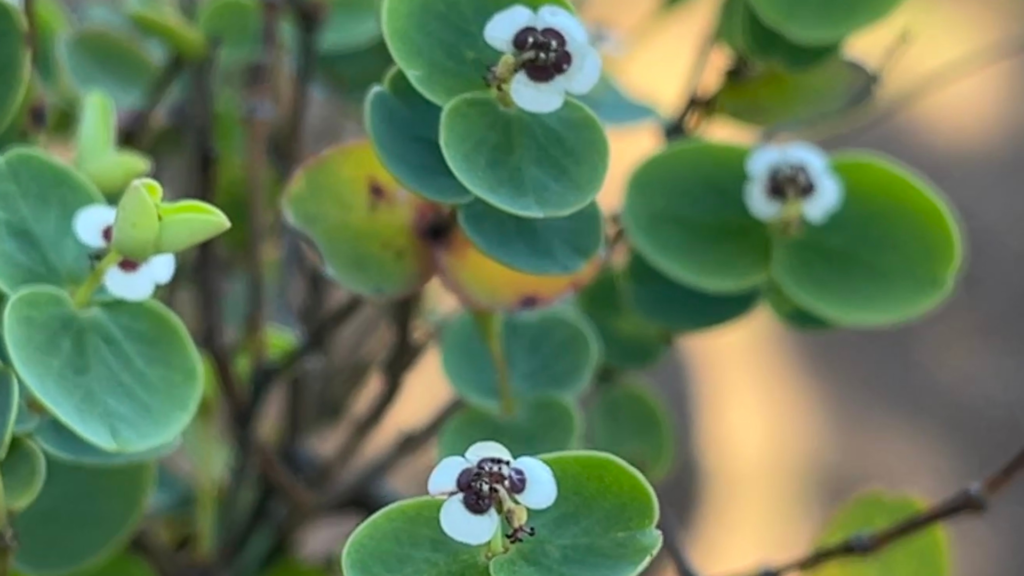
Melicope nealae – alani
Surprising discoveries still occur in the botanical world and Melicope nealae is a great example of one. Prior to its recent re-discovery, this species had only two recorded sightings in over 100 years. Originally collected around 1909 in the center of the canyon of Kauai, it wasn’t seen again until 1960 and remained elusive through the end of the century. In 2015, NTBG received a grant from the U.S. Fish and Wildlife Service to search for Melicope nealae. While Field Botanist Ken Wood made other plant discoveries during his search for Melicope, he never found the intended species. All that changed a little over a year ago when one individual of Melicope nealae was rediscovered. This single individual flowered and went into fruit (pictured here), but conservationists have not yet been able to cultivate it. NTBG has teamed up with the Plant Extinction Prevention Program (PEPP) and are currently working on a cultivation plan.
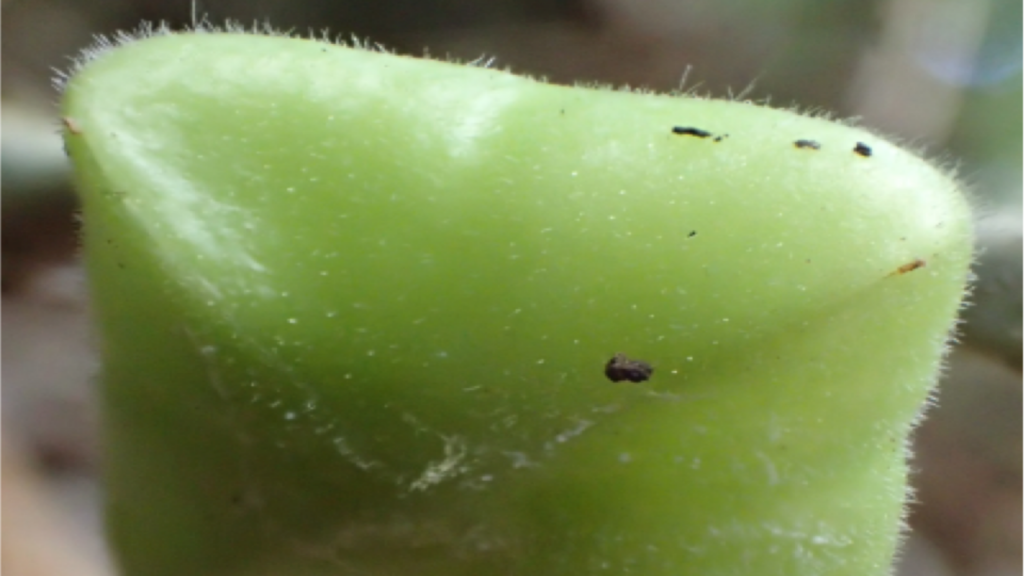
Lysimachia scopulensis – kolokolo kuahiwi
Speaking of looking for one thing and finding another…while Wood and Nyberg were exploring an area of Waimea Canyon searching for Hibiscadelphus distans, Nyberg spotted what he thought might be Lysimachia scopulensis through his drone camera. Continued surveys of the area with PEPP and State of Hawaii Division of Forestry and Wildlife revealed eight new populations of this species with more than one-hundred plants. These new discoveries led to seed collections which are now growing in our Conservation Nursery.
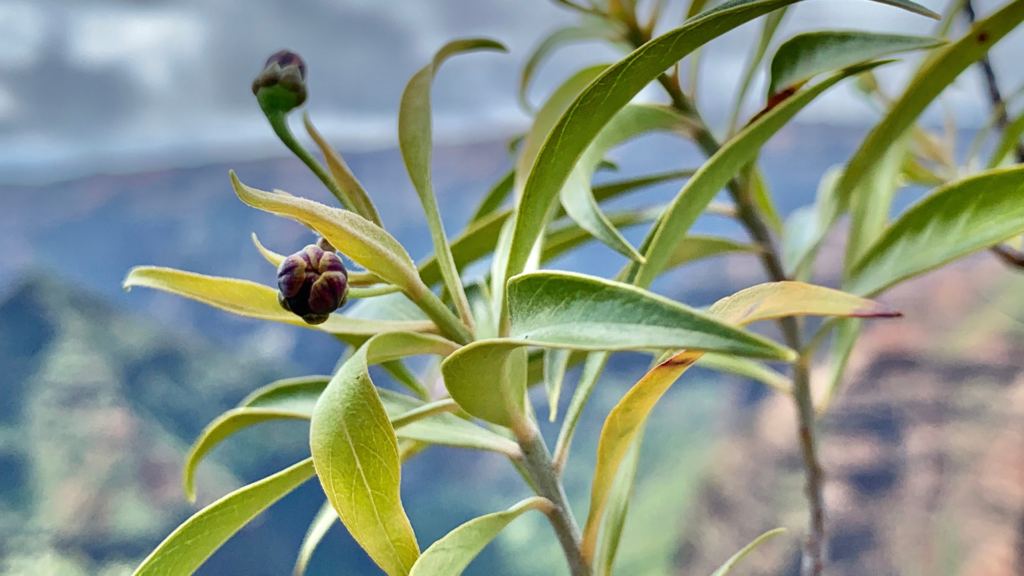
Euphorbia remyi var. hanaleiensis – akoko
What’s really distinctive about this species is the wooly-like hairs on its fruit capsules. It was collected once sometime between 1864-1865 and was never seen again. Behind a waterfall surrounded by echoes of a raging stream, Ken Wood recently discovered a small colony of these Euphorbias. He was able to collect an herbarium voucher and seeds at the time of discovery. Although the seeds collected were not successfully grown, this is an exciting discovery with future opportunities for seed collection.
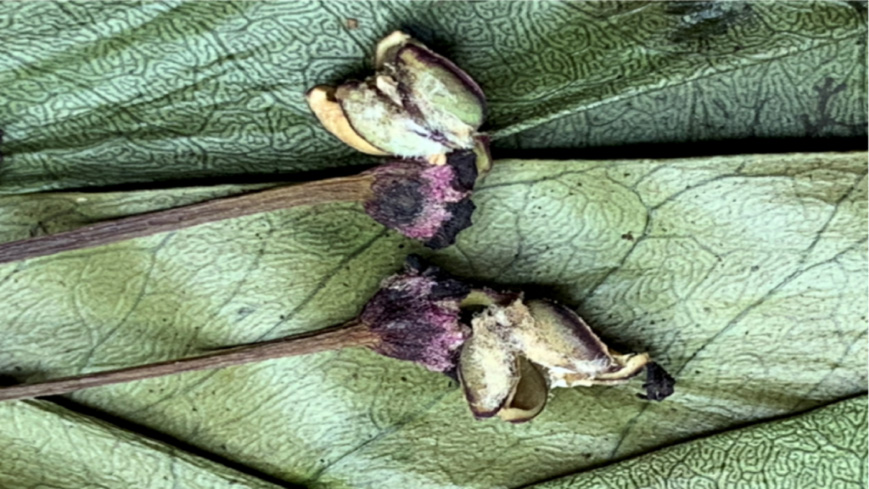
Cyanea asarifolia – haha
While surveying the wet cliffs of Kauai looking for Lysimachia iniki, Nyberg spotted dark green, heart-shaped leaves growing out of a rocky outcropping. Cyanea asarifolia was known to occur in one area a few valleys away prior to this discovery. One day of drone surveying nearly doubled this species’ abundance with a really robust and vigorous population. This species has been difficult to locate as it is one of the few species of Cyanea that prefers to grow on vertical cliffs.
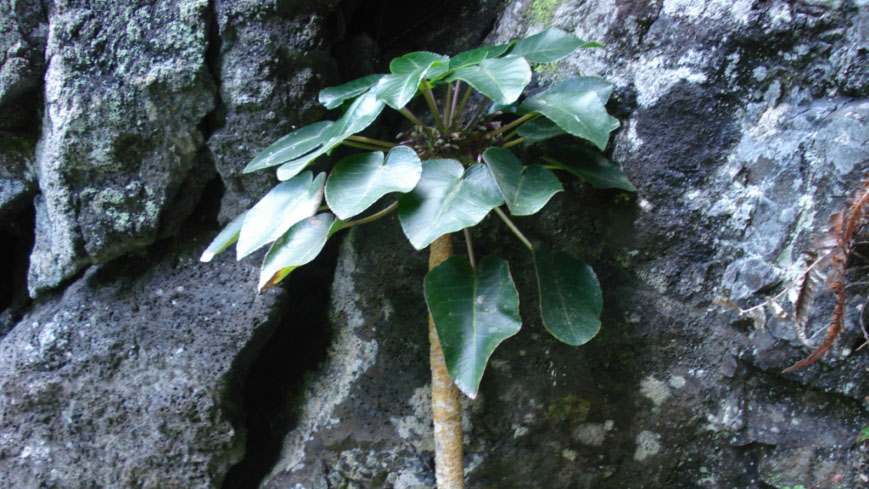
Cyanea kuhihewa – haha
Even though there are a lot of sad plant stories, there’s also joyous ones and Cyanea kuhihewa was one of those. This linear leaf cyanea species was first discovered by NTBG staff in Upper Limahuli Preserve. Unfortunately, the species went extinct after the population was destroyed by the 1992 hurricane. Although Cyanea kuhihewa had never been successfully cultivated, another population was recently discovered. “It was like water on a dry leaf,” said Wood. With PEPP cooperation, Wood went back to the newly discovered colony several times to bag and protect flowers and fruit and eventually collected several thousand seeds giving NTBG and it’s conservation partners hope for this species in the future.
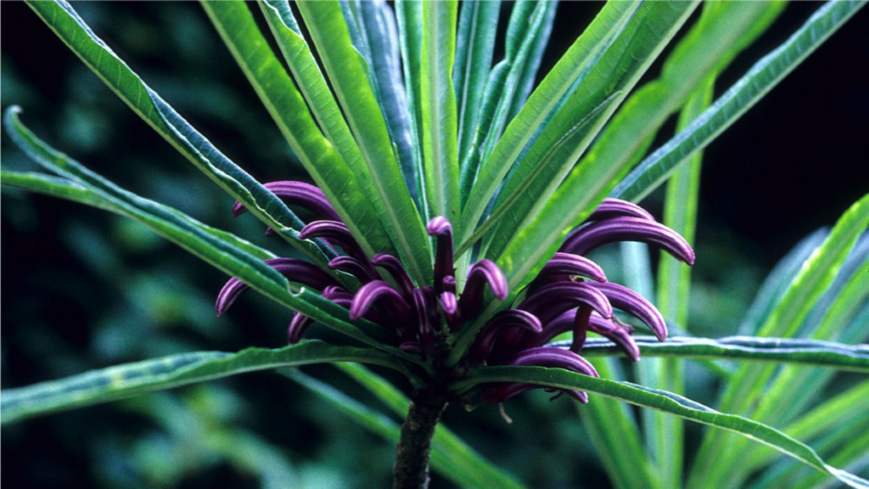
Want to learn more about plant discoveries? Check out the webinar recording below. For decades, NTBG has been roaming the mountains and valleys of the Hawaiian island of Kauai by foot, helicopter, rappelling and more recently, using drones. Field Botanist Ken Wood & Drone Specialist Ben Nyberg share their stories, methods and experience during this special webinar.
Forever Upon Us
Approximately one million plant and animal species are threatened with extinction worldwide. Now more than ever, the need is upon us to protect plants and unlock solutions to the environmental challenges we face. With your help, NTBG has been meeting the need to save plants and stemming the tide of extinction in tropical regions worldwide for more than 55 years. When you support National Tropical Botanical Garden, you help save plants and people. This story is part three of a three-part series. Follow along to learn more about your impact and NTBG’s plant-saving science, conservation, and research initiatives. Read part I | Read part II
Taking in the scenic view of the Lawai Valley from the overlook at NTBG’s administrative headquarters in Kalaheo, Hawaii, is a singular experience. Stretched out before you in the verdant valley below lies McBryde Garden. Home to the most extensive ex-situ collection of native Hawaiian plants, McBryde is a veritable botanical ark of tropical flora.
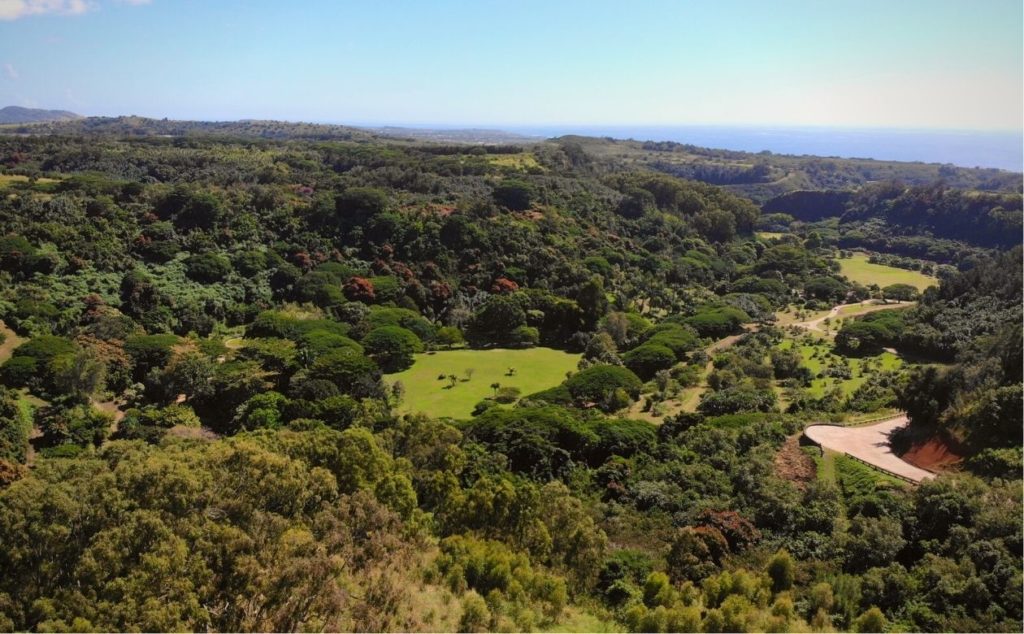
Researchers, botanists, and plant collectors have gathered thousands of species from throughout the tropical world in McBryde Garden to form a living collection that is unparalleled. Visitors can roam through 200 acres of endemic (only occurring in Hawaii) ethnographic and other tropical species, many of which are threatened, endangered, or even extinct in the wild.
In addition to native Hawaiian, Polynesian, Micronesian, and Melanesian species, NTBG’s living collections include tropical palms, Rubiaceae (coffee family), Zingiberales, Erythrina, breadfruit, fruits, flowering trees, ficus, bamboo, and many more. McBryde and all NTBG gardens in Hawaii and Florida provide a haven for imperiled plants. They also present a mesmerizing display of tropical color, shape, and texture to explore and serve as living laboratories for scientists, classrooms, and inspiration for students and visitors.

The Future of Saving Plants Depends Upon Us All
As we prepare for the future and adapt to our changing climate, the relationship between plants and people will become increasingly important. NTBG is committed to bridging the gap between contemporary science and cultural plant knowledge so humans can better understand their impact on the natural environment and unlock solutions to challenges we may face. Inspiring and training the next generation of plant protectors and conservation enthusiasts is up to us.
That is why part of the NTBG mission is dedicated to providing educational opportunities and training programs from kindergarten through university and beyond. To share more about how NTBG is preparing students to be the scientists and plant protectors of the future, we asked Randy Umetsu, former KUPU member and current Horticulture Technician at Limahuli Garden & Preserve, to discuss his unique experience transitioning into a conservation-focused career and what the future of plant conservation looks like through his eyes.
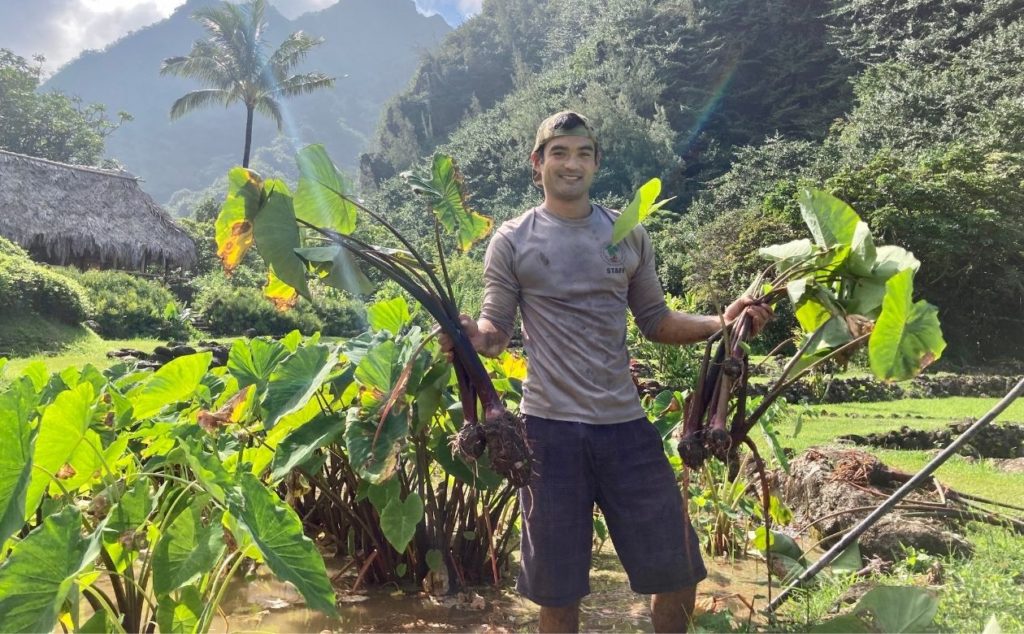
In Conversation: Randy Umetsu, Lead Horticulture Technician, Limahuli Garden & Preserve
Answers have been edited and condensed for clarity.
Q: What sparked your interest in plants?
RU: It’s a long story. In 2015 I was working in Japan in international relations and decided it was time to move home to Hawaii and consider a career change. I decided to look into farming [yes, farming], discovered the Biology and Tropical Agriculture Program at Kauai Community College (KCC), and enrolled. One day the NTBG Nursery Manager came to one of my classes to advertise internship opportunities and said no experience was necessary, so I jumped at the chance. I did not have any experience working with native Hawaiian plants, but I discovered I like growing native species more than food. Growing a part of Hawaii connects me to the place where I was born and raised, and that connection is what has kept my interest.

Q: Why is plant conservation important?
RU: Biodiversity is a crucial marker for ecosystem health, and plant conservation is essential for maintaining biodiversity worldwide. Plants provide the foundation for food, building and clothing material, and habitat for people, animals, insects, and microorganisms. Hawaii would not be what it is today without plants. Ancient Hawaiian society evolved and thrived without using metal tools and modern construction materials. Much of their life-sustaining food, tools, medicine, and cultural practices came from plants. This is why plants and plant conservation is essential. When we save plants, we save people and traditions too.
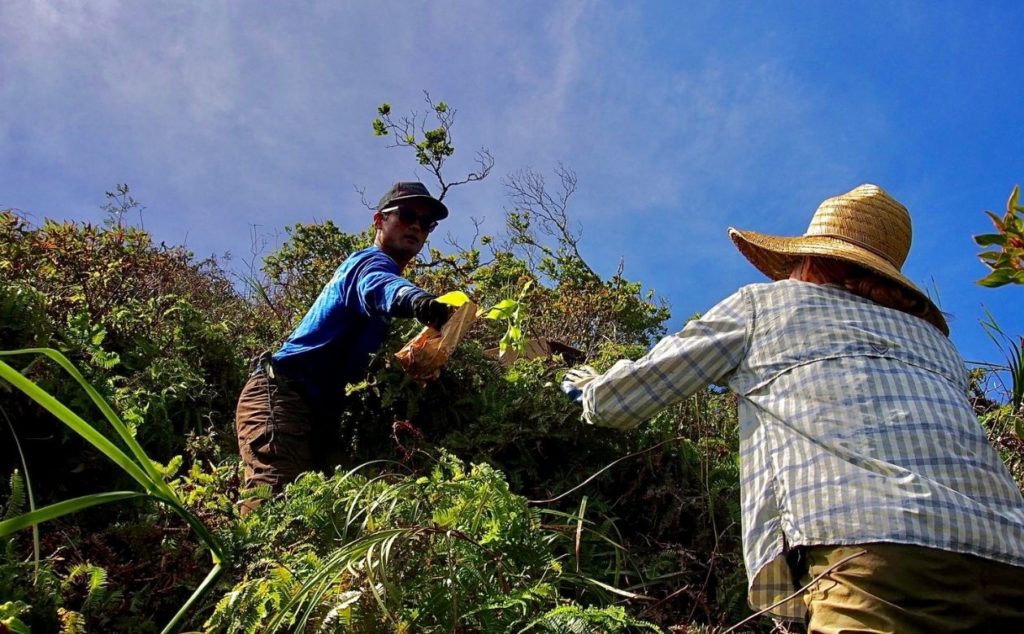
Q: You started your career path as an intern at the NTBG nursery, and now you are a professional horticulture technician at Limahuli Garden & Preserve. What is it like to work in the Limahuli Valley every day?
RU: Honestly, it is a whirlwind. You might be surprised by how exciting and fast-paced working in a garden can be. One moment we are harvesting kalo, and the next moment we’re building retaining walls or clearing debris and assessing damage after a storm. Caring for culturally important places, plants, and endangered species is always exciting.
Q: At Limahuli Garden, we are fortunate to have staff who can trace their ancestral roots to the Limahuli Valley. What’s the biggest lesson you have learned working with them in this Hawaiian place?
RU: The biggest takeaway is learning what commitment to a place really means. To them, stewarding this valley isn’t just a day to day, week to week, or even year to year job. The long-term vision is much bigger than that. Taking care of this place and its plants is a lifelong commitment, and I like seeing it that way too.
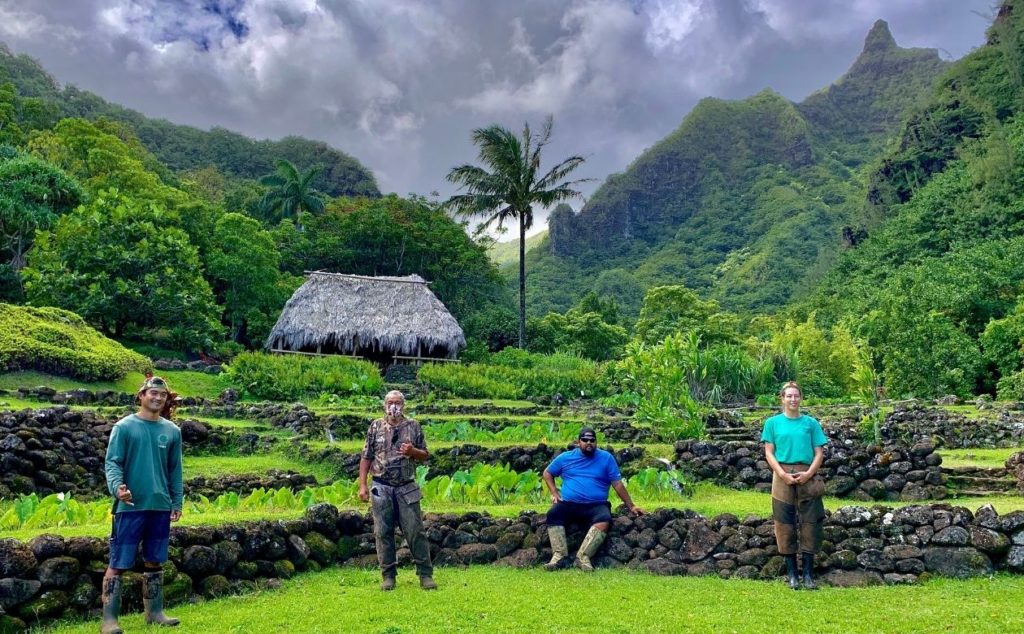
Q: How should someone interested in pursuing a career in conservation get started?
RU: Volunteering with NTBG is a great way to get started. I started volunteering in the nursery, and now I’m working at Limahuli. Look for internship opportunities or programs that provide hands-on experience. For example, I joined the KUPU Program, which helped me get the experience I needed. The NTBG Fall Internship Program, Hawaii Youth Conservation Core, and Pacific Internship Programs for Exploring Science (PIPES UH Hilo) summer internship programs are great options too.
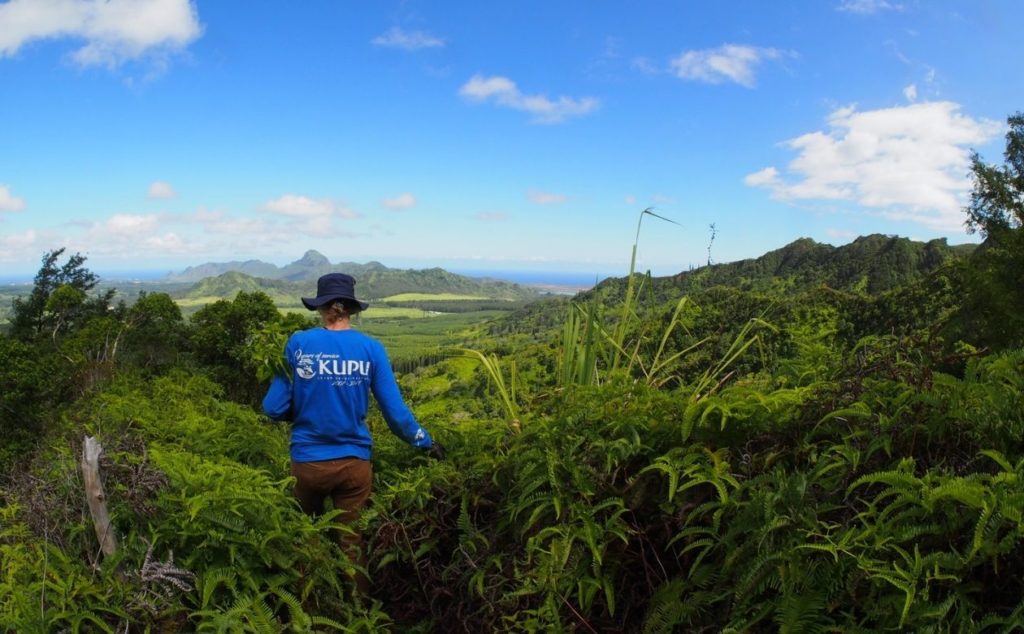
Q: What can people learn from Limahuli, and how can they apply it to everyday life?
RU: Even though Kauai is an island, we are not alone. Everything on our planet is connected. What we do at Limahuli Garden & Preserve and how we do it can be a model for conservation practices worldwide. We’re not just taking care of a beautiful garden people can visit; we are protecting resources from ridge to reef and combining ancient knowledge with cutting-edge science to do it.
Forever Upon Us
Fostering the next generation of conservation enthusiasts and professionals is just one of the many ways NTBG is meeting the need to protect plants now and forever. The Breadfruit Institute’s Regenerative Organic Breadfruit Agroforestry demonstration in McBryde Garden serves as a model for agriculture that can sustain and restore land and decrease food insecurity in tropical regions worldwide.
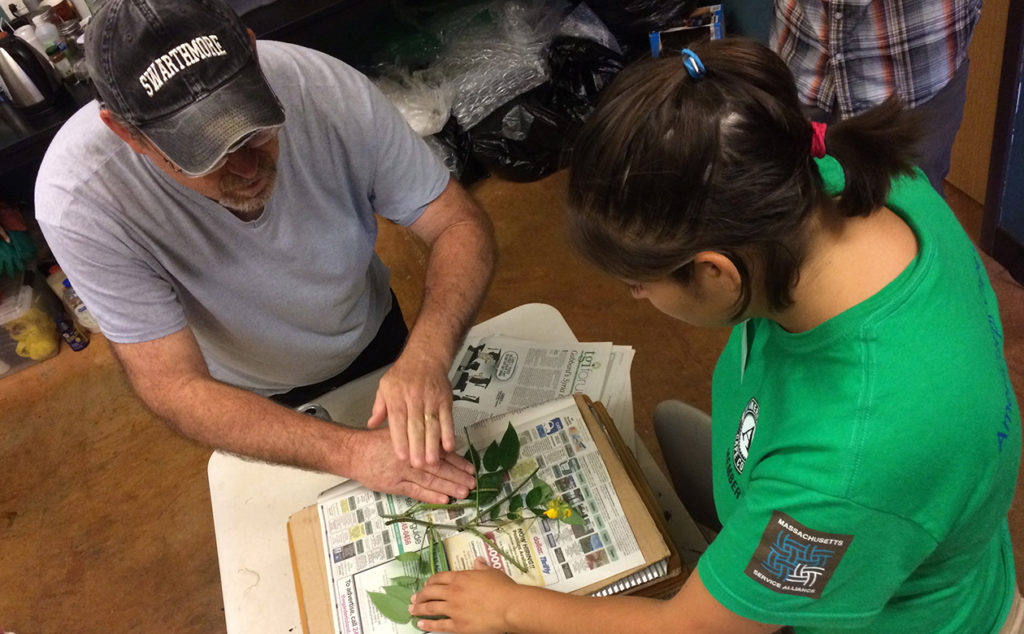
Our seed bank and herbarium collections help safeguard and propagate rare and endangered plants so they can be returned to their natural habitats. Staff and volunteers at the NTBG nursery care for and produce more than 100,000 plants per year, many of which are rare and native to Hawaii and the South Pacific region. Annually NTBG invites more than 30,000 visitors to wander our gardens, take in their majesty, and learn how saving plants saves people.
It is a responsibility we don’t take lightly or carry alone, thanks to thousands of visitors, volunteers, members, and supporters like you. The need to protect plants is upon us now and forever. So please visit, volunteer, or support NTBG with a gift today, and you’ll help us protect plants and people for generations to come.
.svg)

